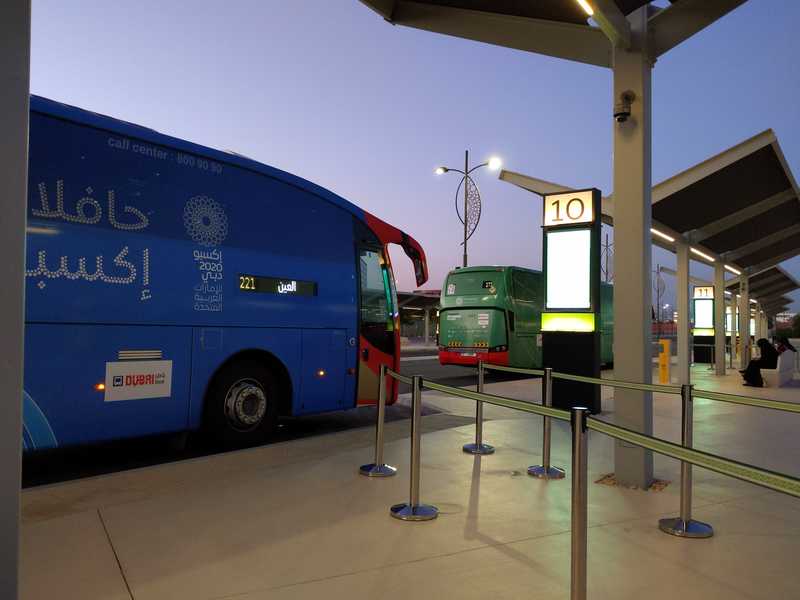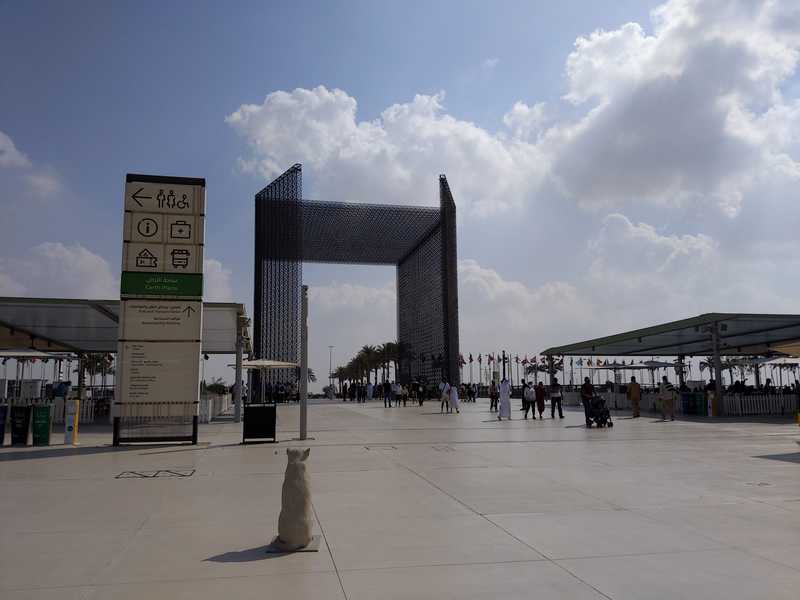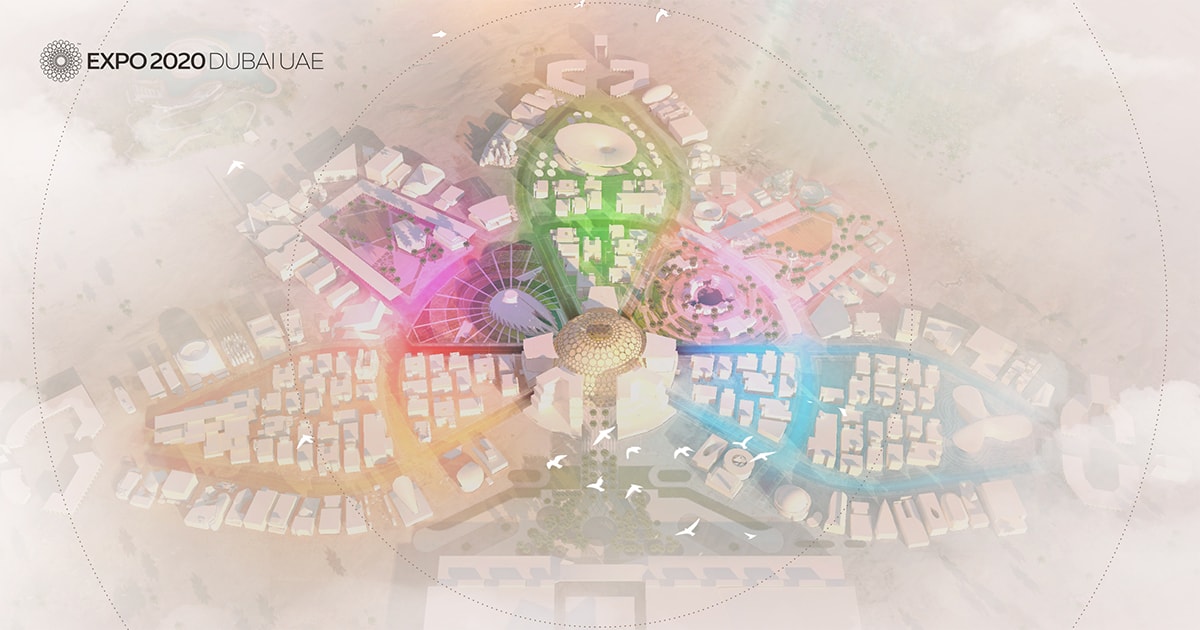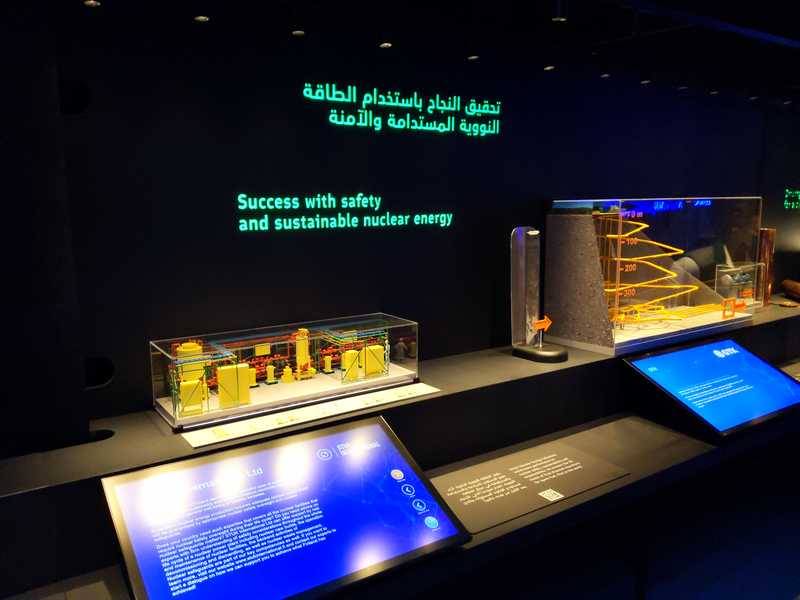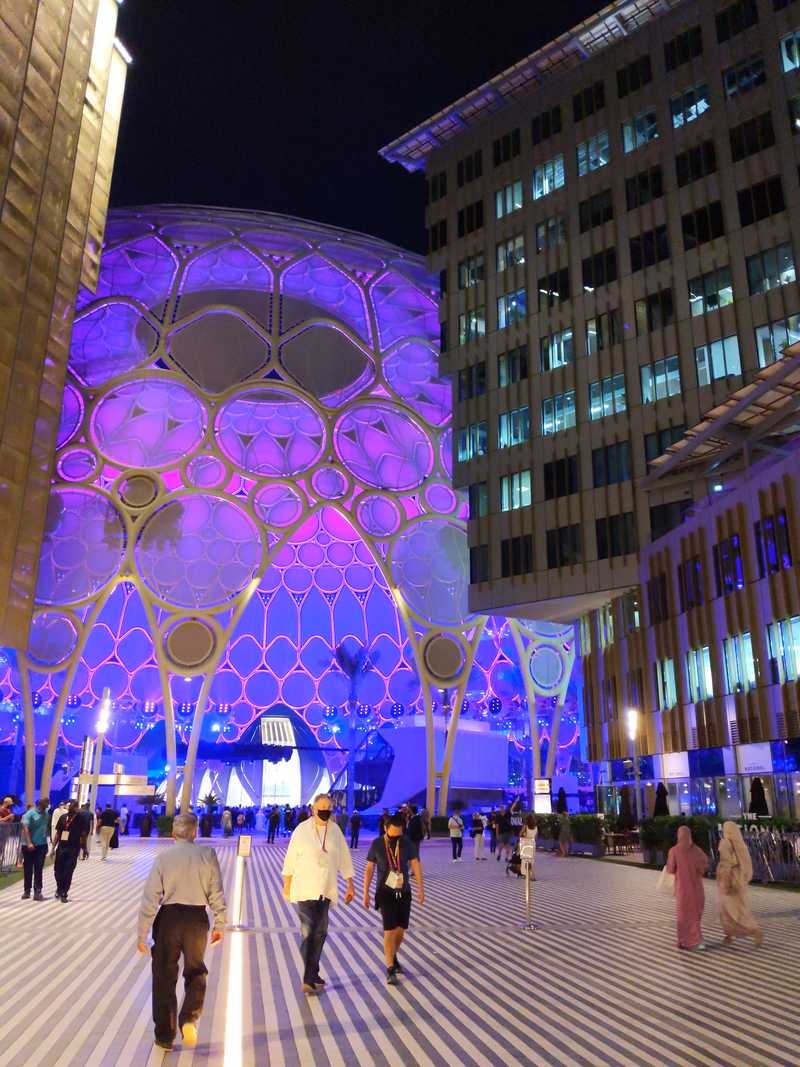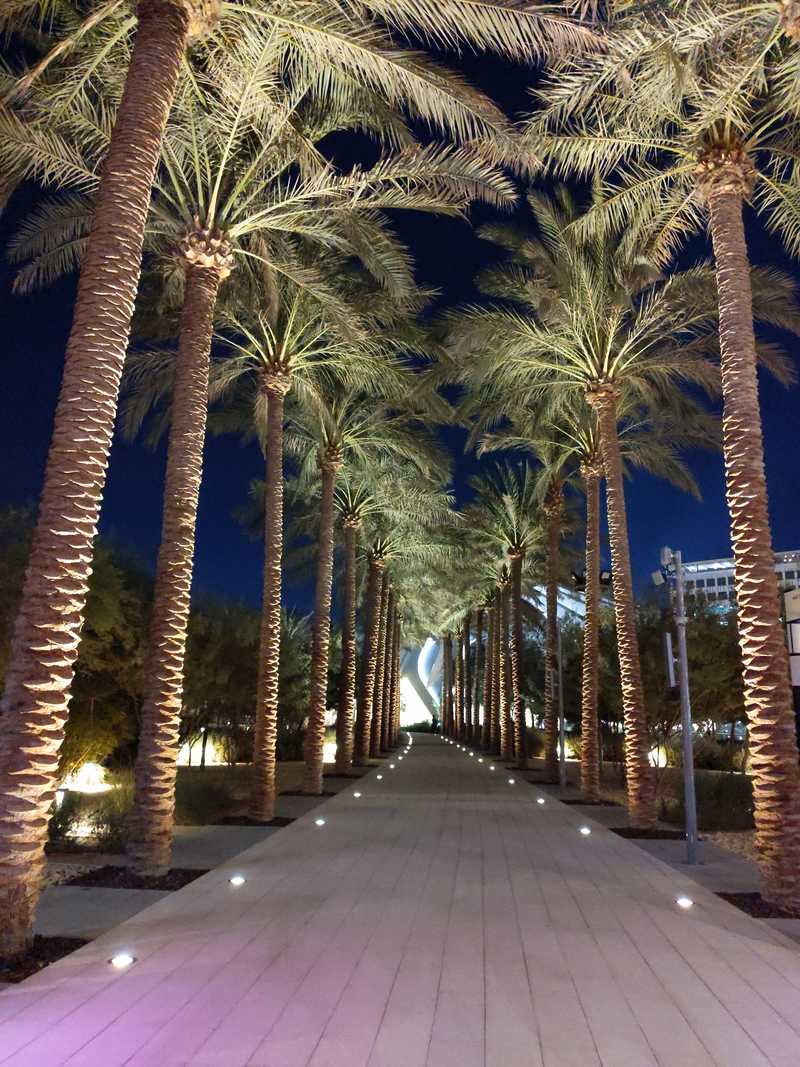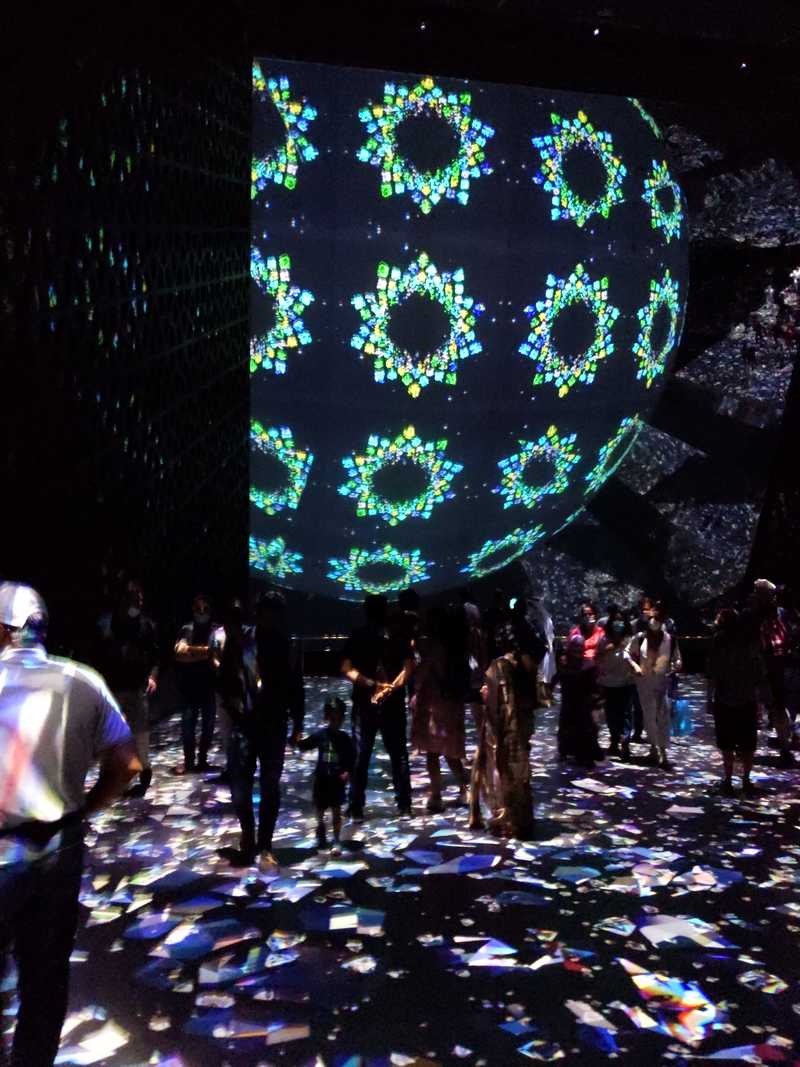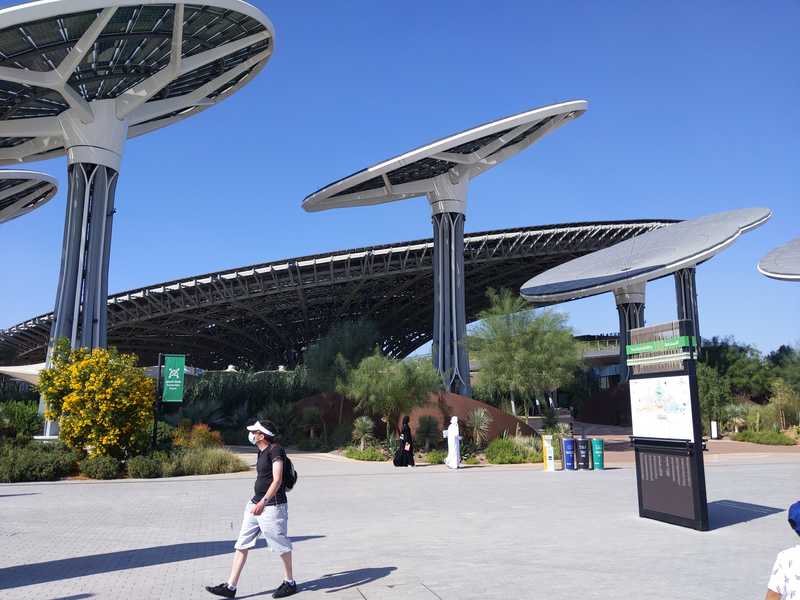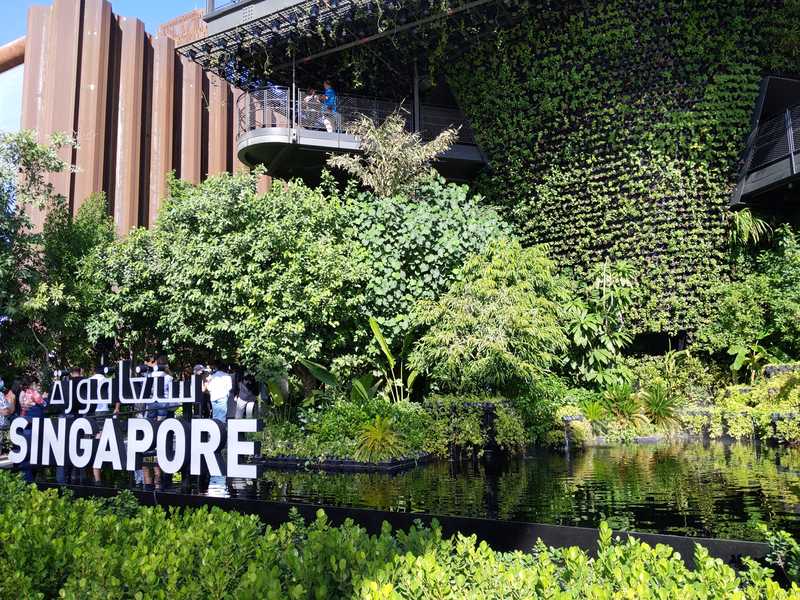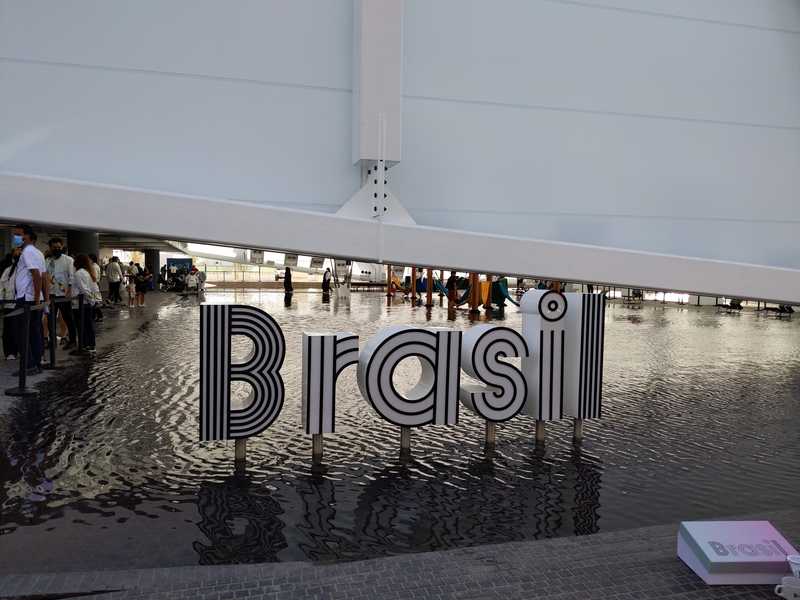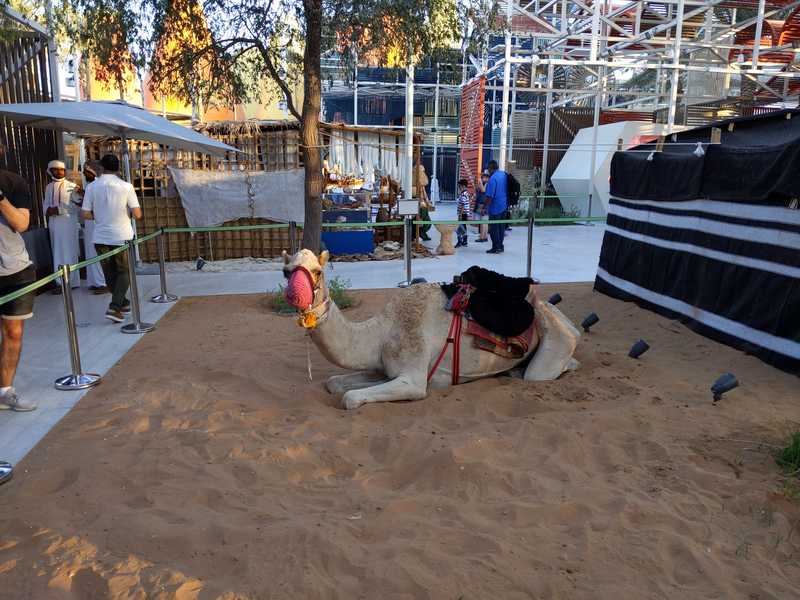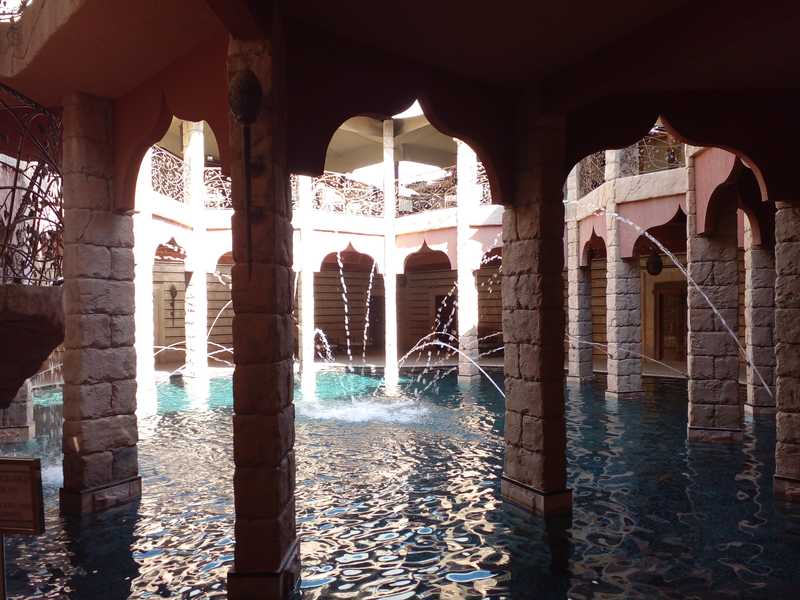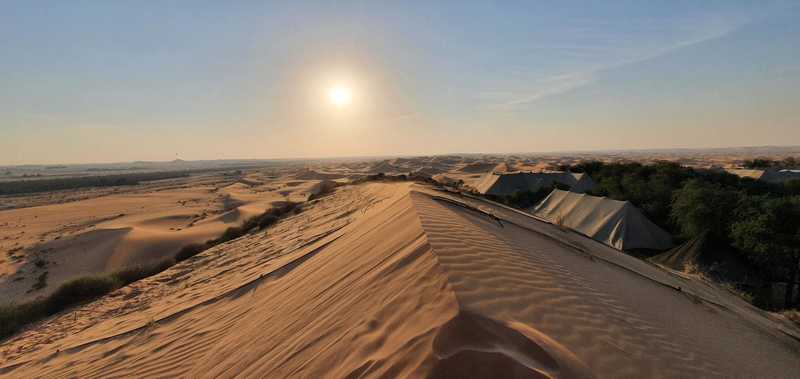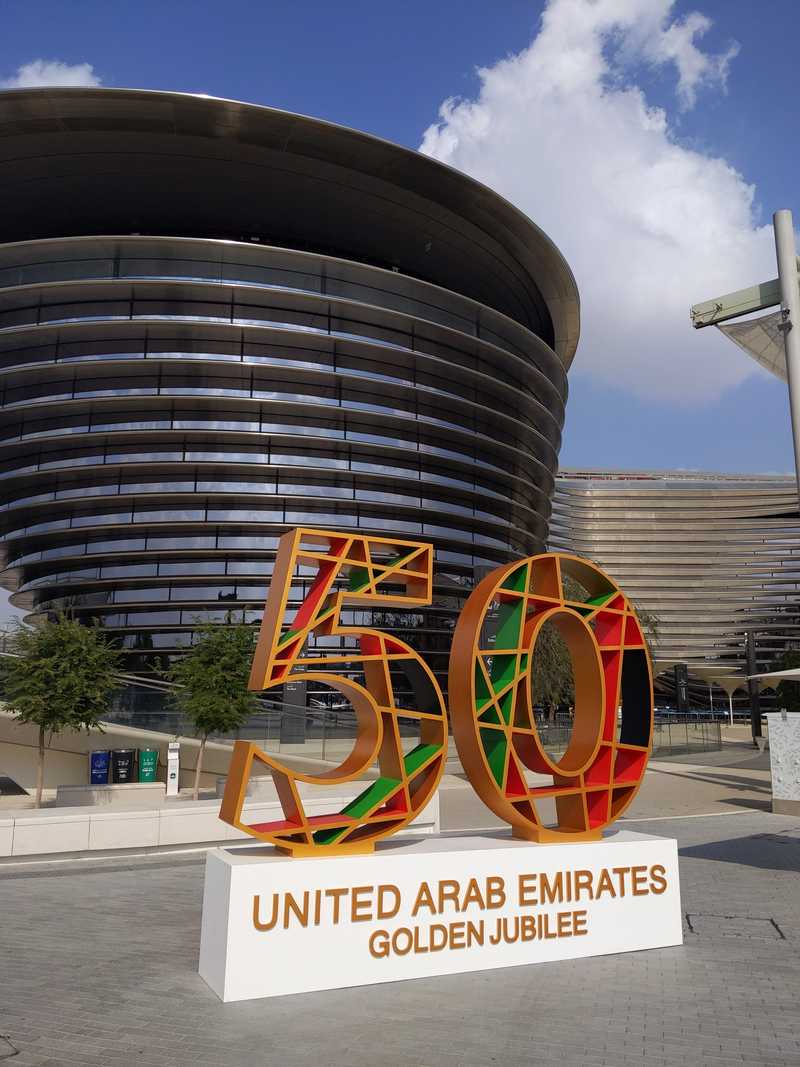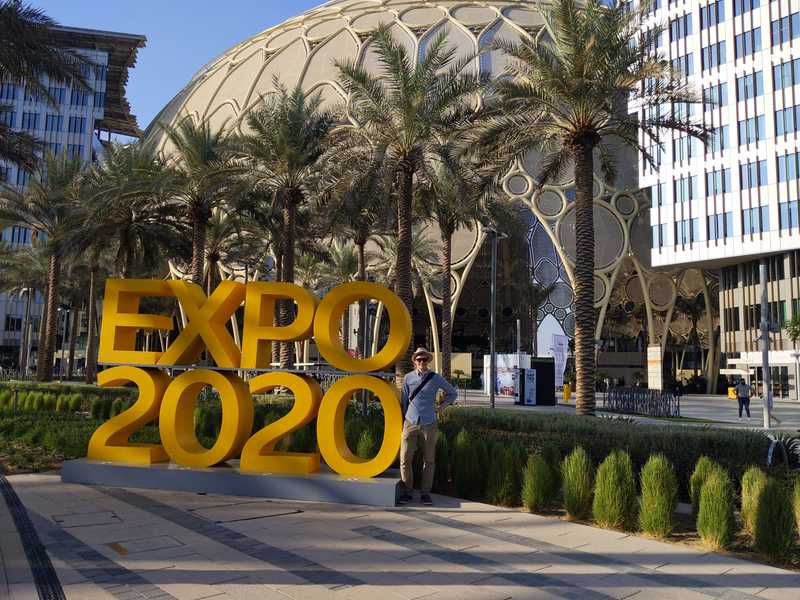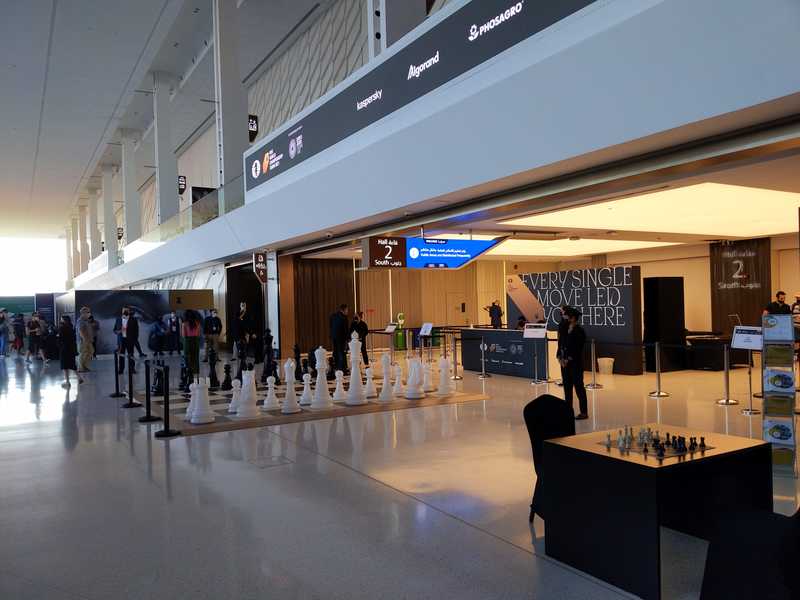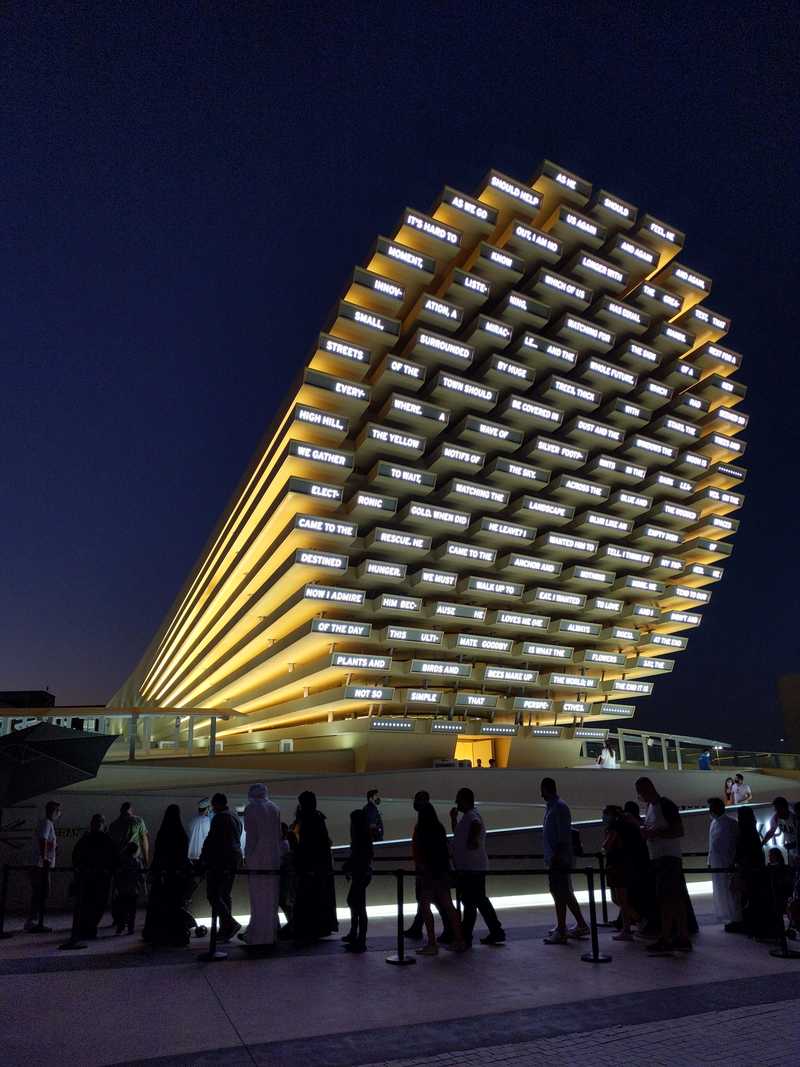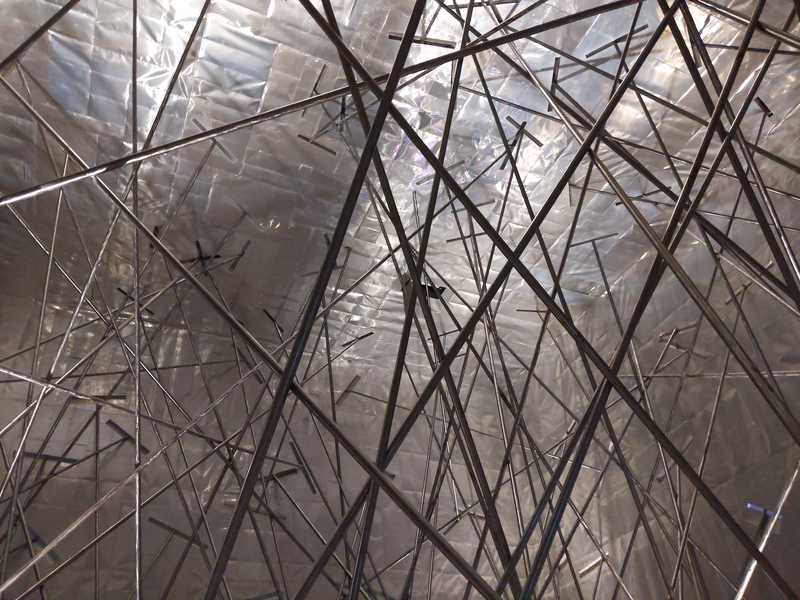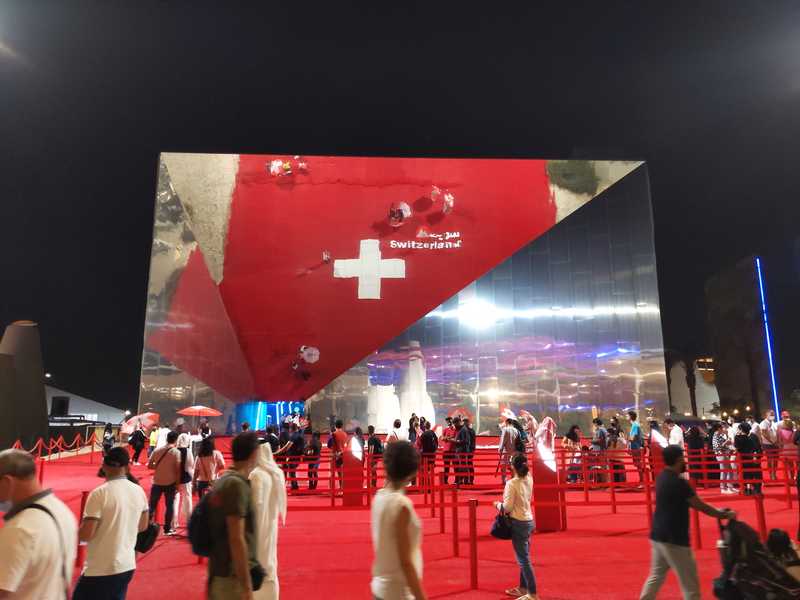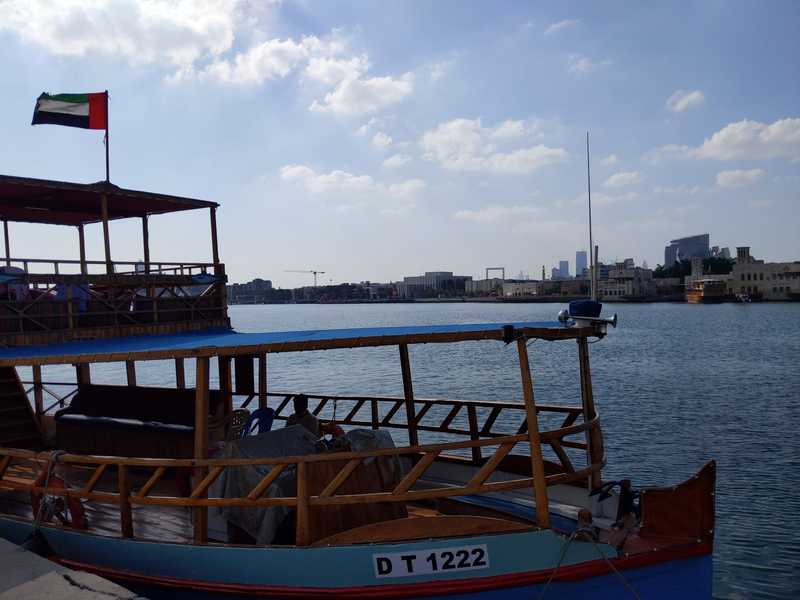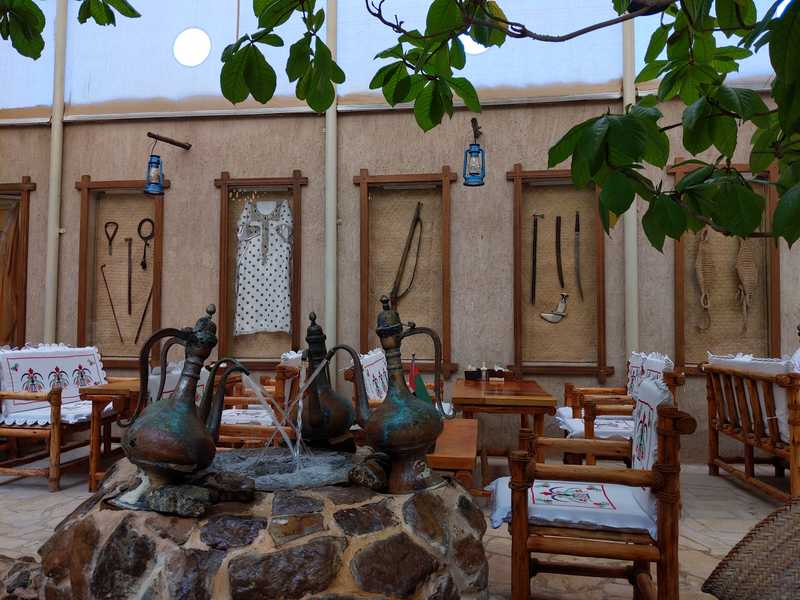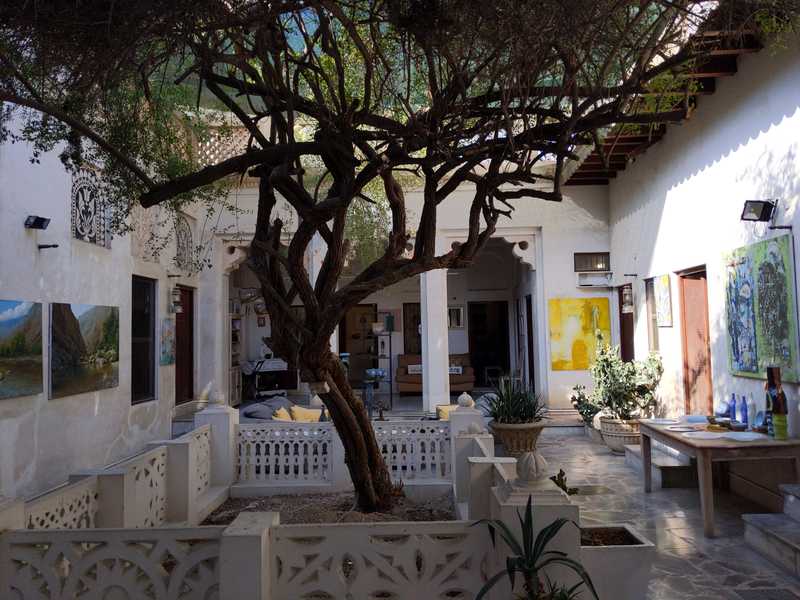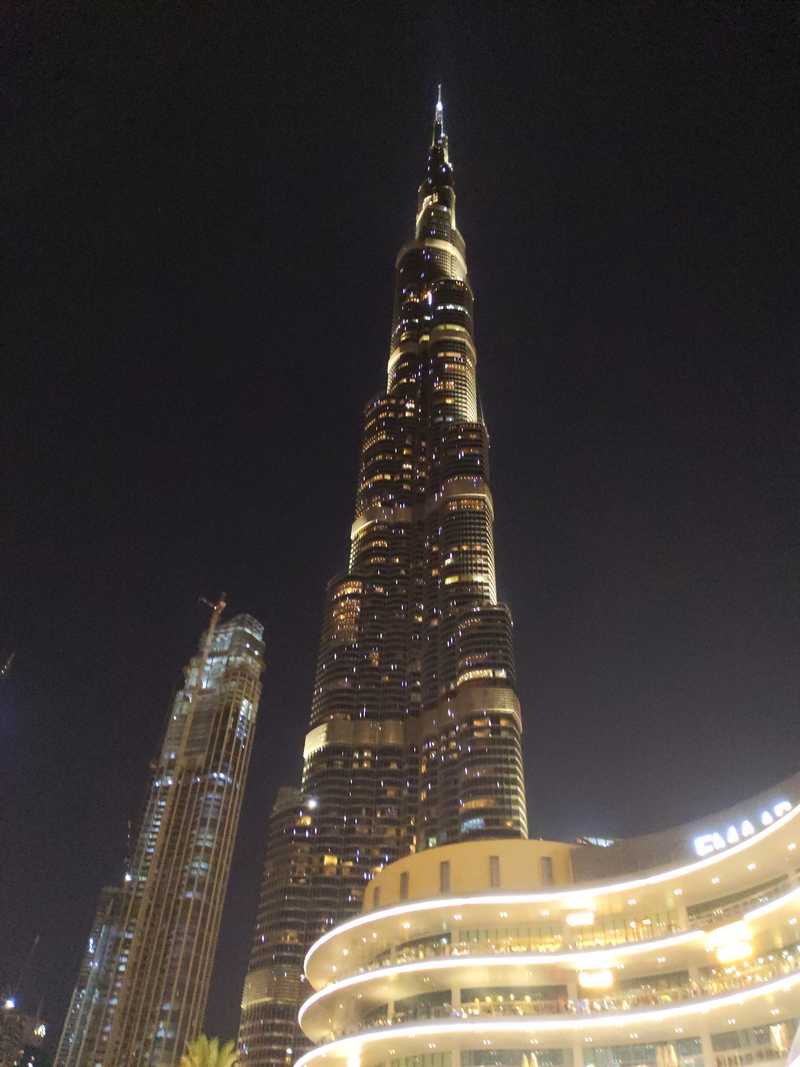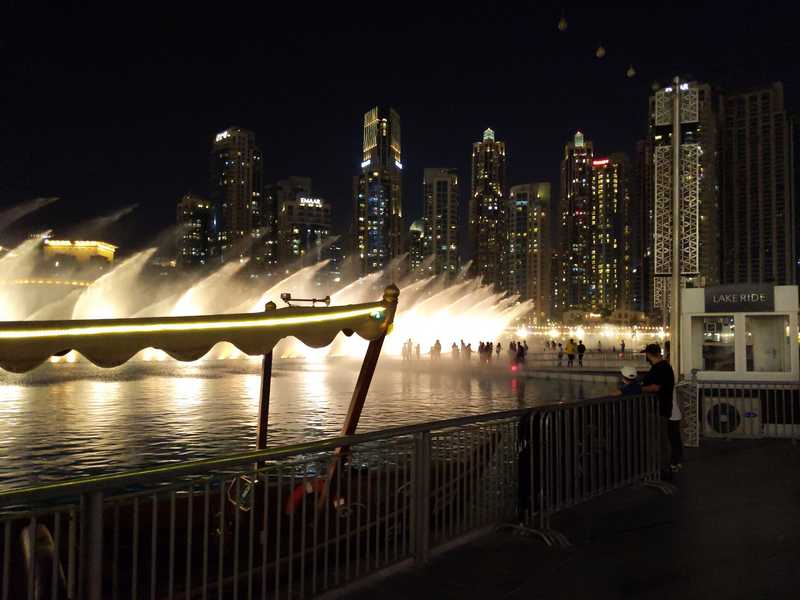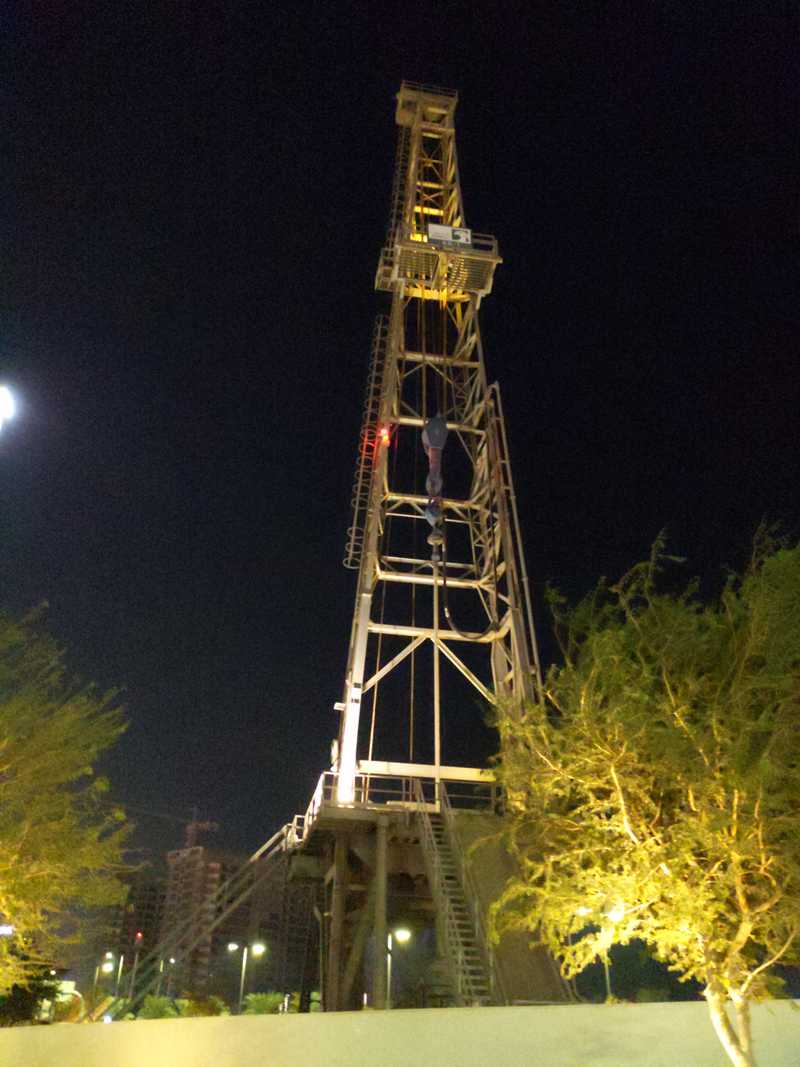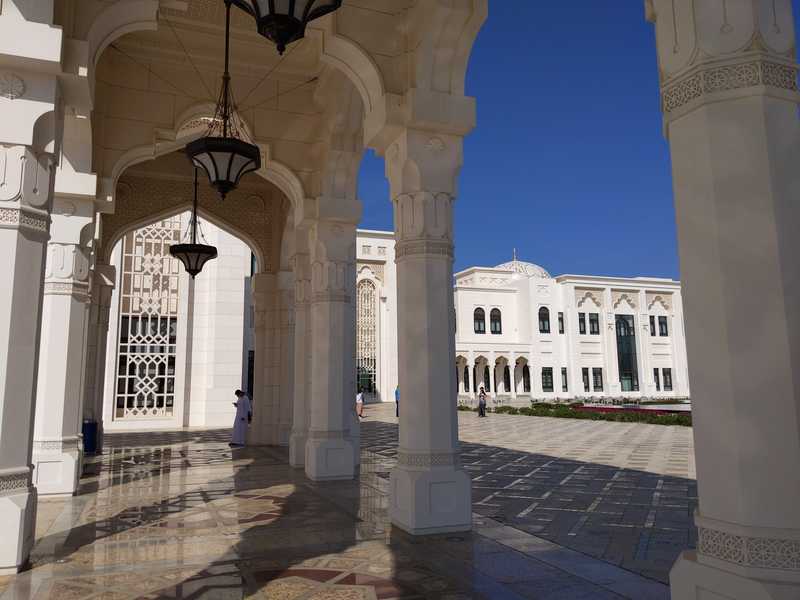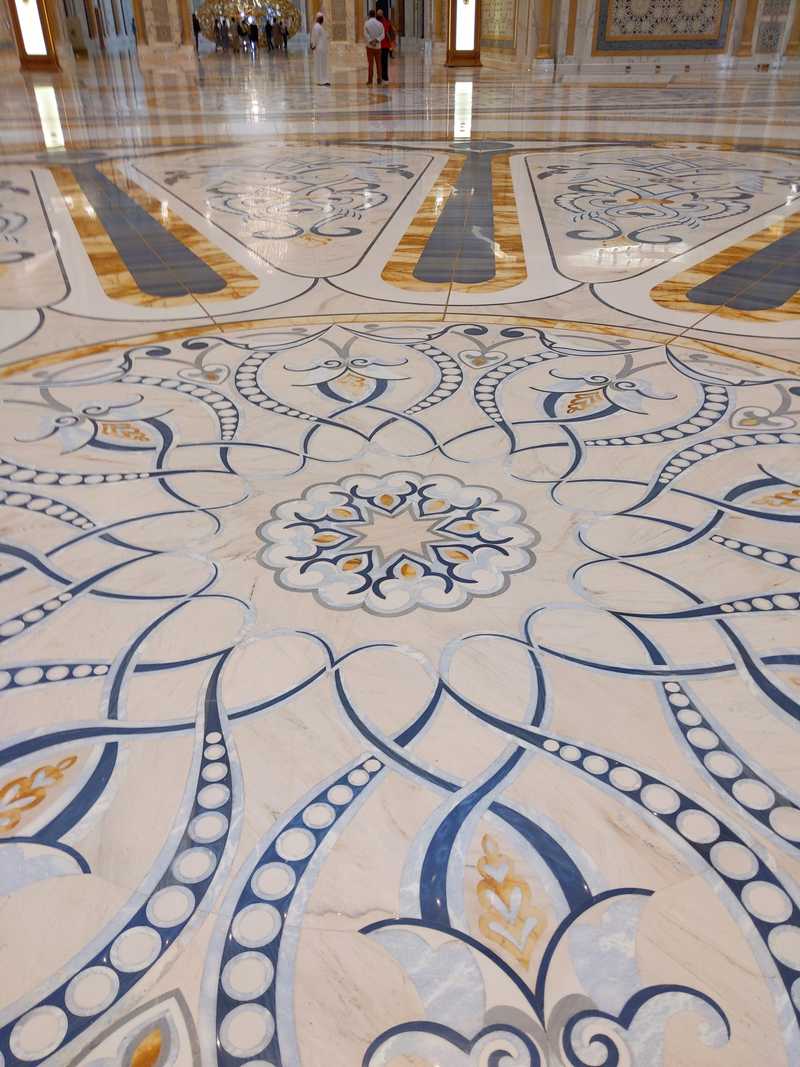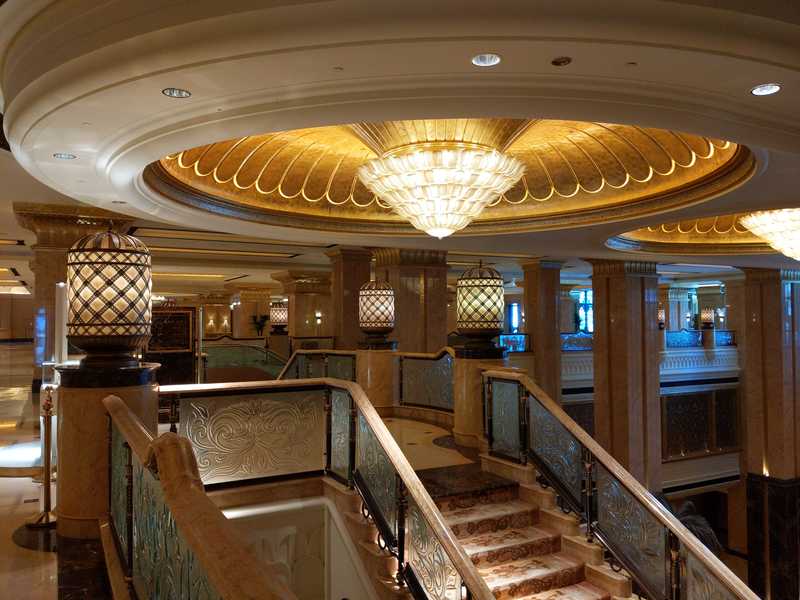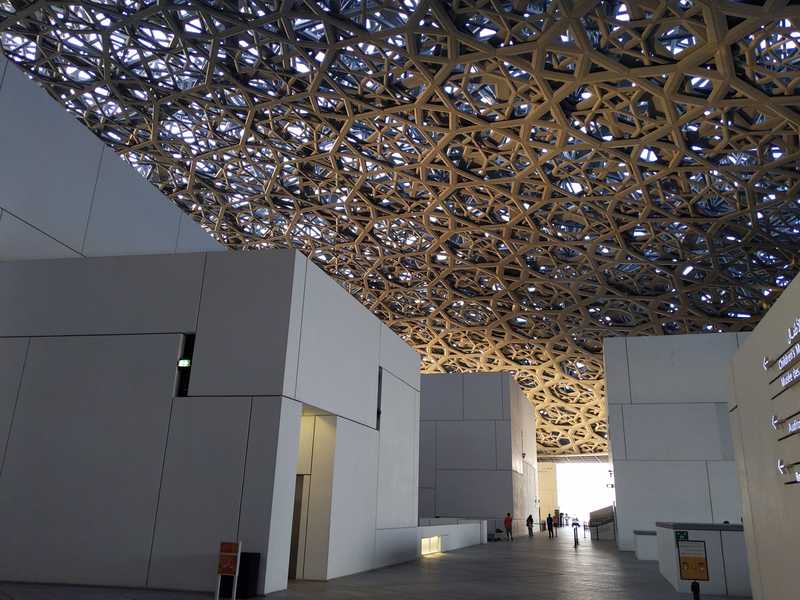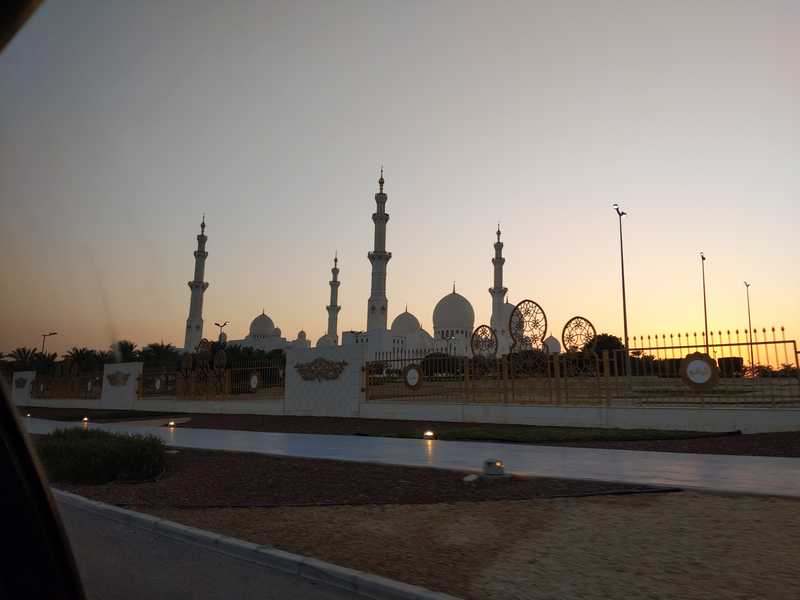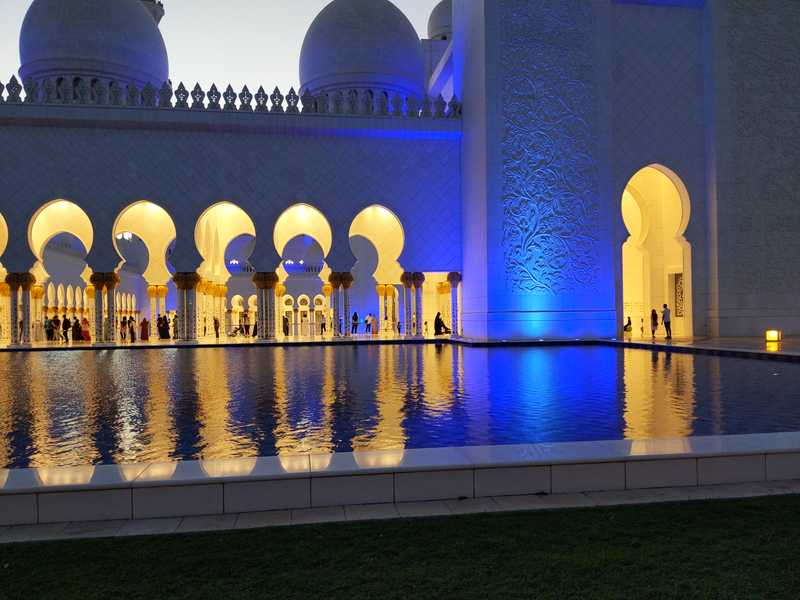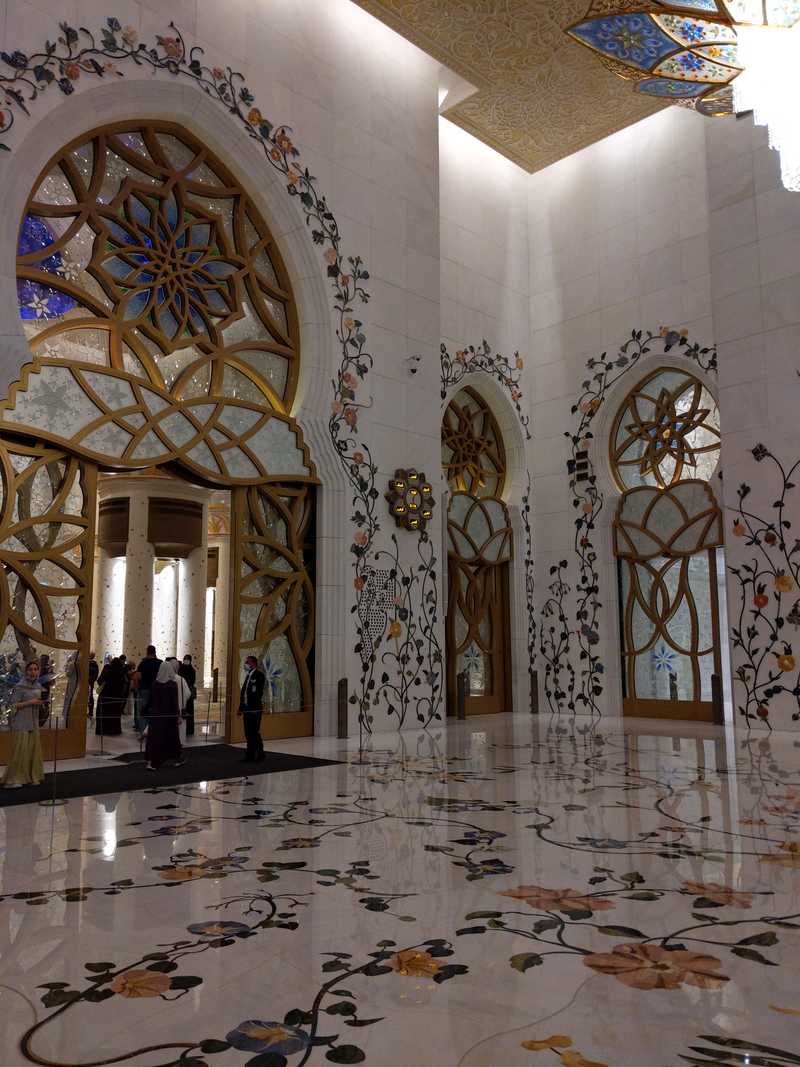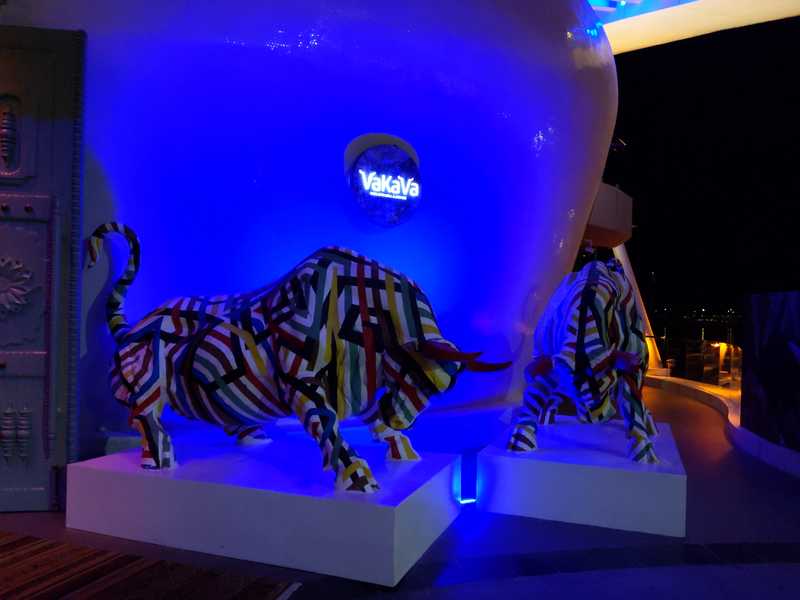About
Travelogue United Arab Emirates, Nov 23 to Dec 02, 2021. My first visit to the UAE.
I saw the postponed 2020 World Expo, the whole world in a village. I saw the skyscrapers of Dubai and the modern wonders of Abu Dhabi. I saw the oasis city of Al Ain deep in the forbidding desert. I saw the 50th anniversary of the federation.
TUE 23 Nov 2021
Arrival
A long flight from London. My first flight outside Europe for many years. I played chess against the aeroplane for maybe half of the seven hour flight. Food service on Etihad Airways was plentiful and more than decent. There was loads of room aboard the plane, many empty seats next to mine. People made the most of the empty rows, many sleeping soundly by nightfall. The cabin was dark for much of the flight.
Lots of things to watch on the infotainment system, fairly recent films and everything. Nolan's Tenet, released in theatres only three months before, already there. Bollywood films dominated the most watched list. The snacks were also mostly Indian goods. UAE is fairly close to India, a three hour flight away. Dubai to Mumbai is roughly the same distance as London to Helsinki. Many come from India and neighbouring countries to work in UAE.
Departing at around noon London time, we landed in Abu Dhabi Intl just after 11PM local time. Flight was perfectly on time, UAE is four hours ahead. On arrival, I was given an instant visa as part of the passport check. The official at checkpoint paid little attention to me. I admired the cool uniforms the officials wore. Both the police and the customs authority had these imposing dark browns and blues going on, complete with a beret.
Long corridors led me through the terminal to the COVID test area, a huge hall with maybe thirty stations for taking and registering PCR test samples. Maybe 2-3 people running each station. Huge operation. Somehow I ended up in a queue where it was me and 20 other passengers, all of them five feet tall construction workers from a flight from Dhaka.
I got swapped and I gave my phone number for the results. I downloaded the app. The people at the test desk happily took my UK number and typed it in. I double checked it many times and was assured that the app will work in a few hours. I was happy to leave it until the morning.
My general paleness, amplified by the lockdown, would have me stand out in all kinds of crowds on this trip. Early on I decided to just sort of walk into the tourist gambit and just take it easy. I didn't even try to pretend I knew what I was doing. A winning strategy: everybody was super helpful and I got only moderately ripped off later during the trip.
Outside the airport it was warm and damp, surprisingly dark, though it was almost midnight. A hundred unofficial chauffeurs were ready to grab my business right outside the testing hall exit. This was the first test for me as tourist far from home. I was tired and keen to get to the hotel, but didn't go for a dodgy black cab. Mostly because I needed to find an ATM to get some cash.
I dived back inside the terminal, and almost got seized by police. One does not simply waltz into an airport terminal doing COVID testing, it turns out. But they let me use the ATM in the lobby, no problem.
The first ATM refused to serve me local currency, probably because it used contactless login. I was slightly worried, walking up to the second one. I hesitated for a few seconds about letting the machine have my card and pin, but I didn't really have an option. I was carrying my travel reserve of a few hundred US dollars, so I was certain I could sort something out, but it would have been quite the hassle if the machine had eaten my card. Fortunately I was able to withdraw 1,000 dirhams, some £200, from my HSBC VISA debit card, no problem.
I had no problem with my card anywhere on the trip. I made a notice of travel to HSBC before my trip, so they didn't hassle me about it. It might be smarter to use a credit card when travelling, but I just went with my debit card. No problems whatsoever during the trip or afterwards.
My hotel for the night was on Yas Island. The black cabs pitched a fixed price of 100 AED (~£20) from the airport to the hotel. From the rank I got a mini-cab size airport taxi that drove me the short journey to Yas Island for 40 AED. I gave the fellow a 50 when he started to make an effort for the exact change.
Radisson Blu hotel, in OK keep, a little run down much like the one I stayed at in Helsinki. Nuanced English from concierge, more simple stuff from rest of the crew. The faucet in my room threw a splash of brown water when I opened the tap. Perhaps the room had not been in use recently. Low water pressure in the shower. Super simple air con, effective. A bidet in the WC, in the French style, a bit of a surprise. English electricals. Unusual scent in the room, pleasant enough. Large windows in dire need of cleaning. A porter brought me a welcome gift: apples and dates.
Just before sleep I downloaded the local COVID pass app called Al Hosn, but it wouldn't accept my credentials. I received a text message about a negative test result, so they definitely had my number down right, but the one time pass I generated from the app simply would not make it through. I could not go anywhere without the app, so I really had to get it sorted somehow first thing in the morning.
WED 24
Breakfast Buffet
Blindingly bright outside behind my thick curtains. I spent a moment just taking in all of the incredible light.
Buffet breakfast, COVID style. The vaccine pass app, Al Hosn, wouldn't fly in the morning either, but the restaurant staff let me in, when I showed my vaccination documents on my phone and the test result from last night. The service was quite different from any hotel visits I had been on before. It was a buffet, but instead of guests filling their own plates, there were these rope barriers around the buffet tables and on the other side of it waiters ready to fill your plate. This obviously caused some delays, but it wasn't too bad.
Most of the food at this fairly basic hotel was imported. Butter portions from New Zealand, etc. Standard hotel breakfast fare, with some local highlights. I couldn't help wondering what is cheap and what isn't. Salmon, cheese, dairy stuff, drinks, eggs? I didn't investigate. Bacon was on the menu as well, a minor surprise.
In general, over the course of my trip, I got the impression that tourists are not really measured on the same ruler as the locals. Hotels, specifically, are islands of liberal behaviour. Plus, UAE in general might well be the most liberal of all of the Arab states.
Lots of staff in the restaurant, everybody on the same breakfast shift. Maybe twice as many staff as usual and four times what a standard Finnish hotel would have. There was a barista guy whose only job was to man the elaborate-looking coffee machine. There were multiple chefs ready to go at the omelette desk.
There was a nice little terrace by the giant, ornate pool, all covered in stylish azure tiles. Deck chairs and shades for the lounging minded. Guests here and there, everybody enjoying a slow breakfast. A pool boy with a 10 feet long cleaning implement. International radio on, groovy RnB for breakfast tunes.
A flock of tiny little birds crowded the terrace, but clearly a truce had been agreed between the staff and the birds. You see the birds want to pick used plates clean, but the staff don't want the birds disturbing guests. The smart solution they had come up with was to deliberately prepare a pile of used plates on one end of the terrace, so the birds could have their breakfast there in peace, out of the way. The staff had also hired a house cat to prowl the terrace and generally keep everybody in check.
Normal hotel folks at the breakfast, a good mix. A few fellas in robes. Some digi-nomads with their laptops out. A little boy, less than two and as tall as the tables, triumphantly walking around from one breakfast group to another. The kid's parents, a good-looking couple, beaming and watching after him. A young woman in pool gear a few tables away having breakfast with her parents. The opposite of the hijab.
Kafka at the Airport
Bright and brilliant outside, the noon sun out in full force. High contrast, sharp shadows. Little mirages in the distance in every direction. I was well covered in sunscreen and had my shades and trusty travel hat on.
I checked out in a bit of a hurry as I wanted to get to Dubai sooner rather than later. Before I could travel anywhere, I had to somehow get the Al Hosn app situation sorted out. My only lead was the airport, where they took my arrival COVID test. I figured there had to be somebody out there that could help, either some customs official or one of those immigration authority folks. I had a funny feeling my prepaid UK phone number was the problem.
The hotel porter was keen on carrying my bag from the concierge desk to the main entrance, and then went to the curb by the far corner of the hotel to somehow magic up a taxi for me. Indeed, seemingly out of nowhere, a car soon arrived. The driver, obviously not a local, gave a master class in efficient communication by way of a two-word English sentences. "Airport, yes. Expo, good."
Back at the airport, I had the pleasure of taking part in a low-key Kafka routine. Everybody at the airport was polite and helpful, even kind, trying their best to forward me to the right people and then the right desk to get my registration sorted. Guards and police everywhere, those cool, perfectly tailored uniforms again. The women spoke perfect English, the men were a mixed bag. I walked up and down three levels of the airport in search of the right people and desks, sometimes stepping out under the sun to cross to different parts of the airport complex.
Finally I found the immigration authority (ICA) service desk. A spacious glass-partitioned waiting room for maybe 50 people. A long, room-spanning desk on the other end in a separate section partitioned off by glass and a small door. At the desk, facing the waiting room, three Emirati guys in robes. I got the impression only one of the three seemed to be there in an official capacity, while the other two were there just to keep him company. They were in deep, almost heated conversation between themselves.
A German-looking traveller left as I entered, leaving me as the only person in the waiting room. I arrived just before lunch time and something about the setup with the glass walls made me feel like I was a nuisance.
There was no ticket system or any registration, so I just walked to the door and waltzed up to the desk. When asked, I presented my passport. The three almost made a show of giving me the runaround. I waited patiently until their conversation settled down, trying in vain to get a feel of what they were talking about in Arabic.
Eventually the fella at the computer looked something up and concluded that the app registration under a non-UAE number would not fly. This makes sense, because the number that powers the app is whitelisted by the UAE service providers. This is done specifically for this verification step that I was not able to complete. I did not pick up on any mentions of this in my readings online. It might just be my prepaid account that caused the problem.
So, I needed a new SIM card. I saw many such booths on arrival, but didn't pick any up because I figured I'd get by without any just on WiFi. Naturally none of these booths were anywhere to be found near the immigration office, so I had to walk all the way back to arrivals, carrying all my gear, in and out of the 30 degree heat.
Well into the afternoon now. I was able to purchase a local sim, and on further reflection picked up a spare phone as well. Charming ladies, both foreign workers, at the sim cards booth and the mobile phones booth. I got a cheapo Samsung Android phone that took ages to set up. I got a new Gmail account going, which I also needed to register as a Samsung account for whatever reason, because apparently I am not in control of any of this stuff. Eventually I got the Al Hosn app loaded up, and was also able to receive a text and call my main phone.
Back to ICA desk with my new mobile number. After lunch, the official fella was much more efficient, and was accompanied by somebody completely new. From the Three Stooges to Laurel and Hardy? Not at all. My man got the job done in excellent time. I engaged in a friendly discussion about Finland and the weather, which quickly expanded to cover the languages of the Baltic and whether there are multiple different languages in use in Denmark and whether French and Spanish are the same language, but different.
The official got the re-registration done and made a hard copy for me as well, which really impressed me. Excellent public service. I was instructed to give the systems a couple of hours to update before I could log in. Fine by me. "Dubai is all business", the official assured me in parting, which I took to either mean that the app is needed everywhere in Dubai, or nobody cares. I didn't stop to clarify. I had a good feeling about the hard copy as a backup, so I moved on. It was 2PM before I had everything together: I had already spent a good two hours at the airport.
Out of the terminal and into the Expo Rider bus waiting outside. The Expo Rider was something I learned about already back in London: a free and direct bus service that links the major travel hubs with the World Expo grounds. I had scouted the location of the airport bus stop the day before and found the bright primary green painted brand new bus there already waiting. I think there were two services every hour during the day from the Abu Dhabi airport.
The bus left on time towards the Mobility Gate at the Dubai expo site, one of the three entrances to the Expo area. Half a dozen passengers aboard, the bus was barely at 10% capacity. Everybody naturally spread out from others, multiple seats between all of us. As expected, the air con started blasting as we set off, but I discovered it semi-adjustable. The minimal setting was still plentiful, but non-violent and fairly quiet. Not a problem, though I did put on my sweater.
I spent most of the drive, maybe an hour or so, just looking out of the permanently shaded windows, taking it all in. After all, I was crossing a stretch of desert for the first time in my life.
Road to Dubai
Wide roads, multiple lanes, six at least in each direction. Each lane quite wide and all of the infrastructure generally in excellent keep. Abu Dhabi — Dubai is a major artery in the country. Right-handed traffic, super fast cars on the leftmost lanes in the middle of the road. The bus, going maybe 80 km/h, easily overtaken by everybody.
Looking around towards the horizon, everything was flat and sandy yellow gray. There were some installed trees and other greenery in orderly arrays by the roads here and there. Lots of construction, roadworks. Heavy duty bridges and overpasses, all covered in simple and effective ornamentation. Fan-like patterns were a frequent motif. Lots of smallish cell towers by the highway. A beautifully put together mosque just north of AD next to a college and a Centrepoint mall. Palace scale, easily ten stories high.
Flat, flat everywhere! No forests or hills in the horizon. More mosques with conspicuous minarets. Lots of national flags draped over walls and billboards. Rectangular sandstone buildings, even perfect squares and cubes used in many places. Pointed Arabian arches on the windows. Small stores side by side on buildings facing and lining the highway, somehow reminding me of American Old West facades. A majestic bridge-roundabout over the northbound highway. Some huge building far to the east in the distance, probably industrial.
A grand hospital to my left, towards the west, with a massive mural of the Sheikh's face on the front. Trees planted in a grid by the road to the west, the orchard seemingly struggling under the relentless sun. I was reminded of olive trees, or perhaps those trees of the savanna. Hardy greens whatever they are, if they survive this climate.
Arabic script inspired ornamentation on a fence between the road and the trees. It's possible the fence was spelling out some sentence, but something about it suggested that it wasn't meant to be read. Sandy grounds and simple shrubbery here and there. A man-made hill to my right, with a massive sign on top for something called KIZAD.
Is that an oil derrick!? Must be. Never have I seen one of those before. More derricks. Some serious high voltage power lines next to the road and stretching out all the way to the horizon. We entered something of an industrial zone some ways away south of Dubai downtown.
Getting closer and closer to the Expo proper. Lots of heavy industry, more heavy duty power lines. Dunes! Huge roundabout in three lanes. Heavy, industrial traffic at 3:40PM on a Wednesday. A second expo bus behind us, this one in bright blue. No traffic lights anywhere, every driver just going for it! Incredible vehicular ballet as the cars navigate the traffic. Dubai World central HQ. IKEA distribution centre. Al Maktoum Intl Airport.
Finally the expo site at the southern end of Dubai City, on the edge of a fairly bleak warehouse district. Pretty much like an Olympic village in the middle of nowhere, just a brand new metro line coming in. Fortunately the pavilion buildings easily make up for the relatively shabby location. There's a definite Disneyland vibe on the approach. One could easily see the Expo infrastructure from a good distance away and so get excited about the visit.
For the whole journey, the TV on the bus was adamant about informing me about the strict bylaws in effect in UAE and the Expo area. Nothing unexpected there.
I checked on my brand new UAE phone and SIM card as we arrived to the Expo gate. It all worked like a charm. My man at the ICA desk had set up everything just right and I got the coveted green pass to show up in Al Hosn on my second phone. I spotted numerous people carrying two mobile devices on them.
The Expo
The Dubai Expo, Expo 2020, was the first BIE World Expo held in the Middle East. Originally scheduled for winter 20/21, the expo was postponed by a year because of the pandemic. Despite the delay, the organisers decided to keep the old Expo 2020 brand for the fair. Be sure to check out the Virtual Expo experience as well.
Expo 2020 was my first expo, my first ever visit to a world fair. Going in, I had some kind of a clue of what to expect, but it wasn't like I was looking forward to anything in particular. Pretty much all I knew was that various countries and other players would be presenting pavilions, and within those pavilion buildings the exhibitors would then showcase different things.
The expo had an overarching theme — "Connecting Minds, Creating the Future" — and three focus areas, or sub-themes, to which the exhibitors could then respond. Each focus area — Sustainability, Mobility, and Opportunity — had its own pavilion neighbourhood complete with a central theme pavilion. Each sector also had its own massive expo entry gate, so visitors could arrive from all directions.
The expo site featured a central hub that connected the three districts and hosted the grand stage and some administrative buildings. There was also a dedicated metro station; countless restaurant options and refreshment kiosks from all over the world; criss-crossing shaded avenues; multi-function utility buildings with lavatories, washrooms, prayer rooms and little shops; plus various event spaces, installations, public art, and other destinations.
The expo events programme had some variety to it, though I didn't dive into the events that much. It's safe to say there were all kinds of country-specific and more globally oriented things to discover. Much of the programme that I did see repeated on a daily or a weekly basis, meaning that the proceedings had a certain touristic or performative show aspect to them. Expo staff from all nations of the world scattered about inside and outside the pavilions.
In a way expo pavilions are attempts at articulating and somehow capturing the essence of the exhibitor's identity. The pavilions draw heavily from the culture and history and brand unique to the exhibitors. They celebrate accomplishment, outline visions for the future, and present a polished version of the exhibitors' character. Every country and every exhibiting sponsor at the Dubai expo wanted to appear as the place where people thrive today and tomorrow, and where there's unlimited opportunity for those who want to build the future.
In many ways, the expo is a manifestation of a particular kind of a bright-eyed belief in progress and all the good things that the future can bring. It's a peculiar mixture of congenial Olympic spirit, Disneyland vibes, a world cuisine food court, and Silicon Valley-esque anxious future-building. I discovered sincere positivity, but disillusionment as well. Behind the facade, there's only so much one can put together and sustain over the six month lifetime of the expo.
The overall impression I got of the expo was that of a small, modern, carefully planned town or city district, where each house had a different country theme. A grand exhibition of the world, all within a square kilometre or two.
Mobility District
Out of the cool shade provided by the Expo bus and under the brutal mid-afternoon sun high above.
Careful screening at the entrance, but I got in with my bag. I showed my ticket and my brand new green COVID pass in the Al Hosn app. Just behind the gate I found nice website-operated lockers. I could leave my bag there for the rest of the day for a very reasonable price. After some rebalancing, picking up the essentials into my day bag, I was ready to head out to check out the Expo in earnest.
It wasn't until I grabbed a portable map and looked around that the absolutely overwhelming size and scale of the expo really hit me. Spending an hour at each pavilion would easily take a full calendar month — and long days at that. Realising this, I resolved not to try to "see everything" and instead went with more of a serendipitous approach. All I really wanted was to get some sense of the expo as a whole, and to check out a few specific pavilions. I was planning on returning on subsequent days, and in my mind settled for a day-per-district pace.
The pavilion visits themselves quickly transformed into a kind of a search for memorable impressions. I was out to discover fragments of the exhibitor identity. I took lots of pictures and some notes here and there, but I wasn't in a full journalling mode. I was moving quite fast with the crowds, but on occasion I would force myself to take some extra time to appreciate what the pavilions were trying to communicate. I suppose in a way I was trying to capture a singular moment or impression of each one I visited, so perhaps I'll try to do the same here.
Australia was nicely situated as the first pavilion in the Mobility district. I sat down to see a 360 degree immersive film experience detailing Australian nature and the southern night sky and related mythology. The second room had more projections, highlighting features of the Australian economy and sciences as well as tourism. Less than 10 minutes in total. Many pavilions made extensive use of this kind of room scale projection technology.
The Aussies had a nice little shop and courtyard space with excellent food options spread over several little take-away stalls. I was starving and had a quick bite from the barbecue, fighting hungry flies that quickly gathered around my plate in the windless, semi-open space. Good recycling options everywhere throughout the expo, extremely clean streets and generally fantastic public infrastructure.
Next up was Denmark with Danish business stories and products on display, a rooftop restaurant and a lookout tower for views over the Mobility district. I stopped to admire lava stone furniture from Unknown Nordic. The Danes had brought a strong trade show energy to the expo.
Next door was Oman, UAE's neighbour on the peninsula. The two countries have a good working relationship, numerous economic and cultural ties and so on, but relations between neighbours are always special and sometimes a little testing. Oman had gone for a simple high-concept pavilion idea built around their famous export: the aromatic frankincense. A vendor was selling Omani halwa outside.
Three pavilions down I had to take a break and went to check out the nearest "visitor centre", one of several identical rectangular white facilities buildings scattered about the expo site. I couldn't help being reminded of Theme Park and Tycoon series of management games, where ensuring that guests have ample facilities available to them is a key gameplay mechanic. The centres had prayer rooms, a little corner store, water fountains, vending machines, and more. There were various seating options, and people had gathered around to make use of them.
I was quite intrigued by the visitor centres. They served as a liminal space, an outdoor waiting room for people who didn't want to be anywhere in particular. Public space at its finest.
One final thing about the visitor centres: the lavatory facilities served a range of different customs. There were all kinds of porcelain constructions to choose from — urinals, bidets, you name it — but other options as well, starting from a hole in the floor. There were rooms for various washing practices and so on. Plus, there were also some variants for the disabled, or "people of determination", as the official term goes in the UAE. All in excellent keep. The expo really went out of its way to meet the needs of guests from all over the world.
All refreshed, it was time to visit the only pavilion that I had scouted in advance: Finland. Finland had a nice "snow-covered" rectangular structure with a central quiet space that reminded me of Kampin Kappeli. The exhibition featured Finnish technology from nuclear waste disposal solutions to 5G towers and more. The indoor vertical strawberry farm was not in great keep, unfortunately. Gift shop had the Moomin gear and the Iittala designs and the Fiskars tools you'd expect. I had a quick word with some of the Finnish staff greeting visitors outside.
By the pavilion exit I found an official expo country stamp machine. It turns out that the expo shop sells an "expo passport" that one can try filling in with country stamps in order to tick off and "catch them all". During my stay I saw several people, young and old, rush in to get a stamp on the book only to immediately rush out again without looking around. There are certainly many ways to enjoy the expo. I chose to stamp my expo map instead.
From Finland to Algeria. Like the Finnish one, the Algerian pavilion was organised into a nice little loop, with displays, small exhibits and posters on the walls. Responding to the district theme perhaps more than the previous exhibitors, Algeria had a nice section on the north-south Trans-Saharan route across the great expanse of West Africa. Remarkably Algeria and Nigeria are separated only by Niger in the middle. The proposed road would span the Algerian nation and reach from Algiers on the Mediterranean all the way to Lagos.
Next up was Serbia with a large, futuristic pavilion bathed in vibrant reds and blues. Serbia leaned heavily on their young, fresh digi-nation credentials and this "Silicon Valley of the Balkans" brand I'd never heard of. Lots of digital design vibes, virtual exhibitions, real-time avatars and more. Cool e-bike designs from Ono Bikes. It turns out IT is Serbia's biggest service export, digital transformation is a big deal. Slightly surreal exhibition.
Turkmenistan had more surrealism on display with the nations authoritarian ruler prominently displayed. There was a large welcome room, a hall with an "interactive hologram" exhibit. The main exhibition space was on the second floor. The local Emiratis, and especially the ruling Al Maktoum family of Dubai, are keen horsemen, as is the Turkmen leadership. The pavilion therefore featured the Turkmen Akhal-Teke horses prominently with a sculpture out front and displays inside. The Turkmenistan pavilion also featured petroleum goods and geology.
Extremely cool-looking Russian pavilion had such a long queue outside it I had to keep going. There were some cutesy bear statuettes outside ready for photo ops. "From Russia with love."
I continued to Angola on the other side of the boulevard. Angola had a large pavilion structure, but fortunately it also had a natural track that one could easily follow. Angola had a recorded welcome message from the head of state, a great little feature I saw replicated in many pavilions. Angola made a big deal of various social and education programs, highlighting Angolan dance culture, storytelling, and modern art. UAE doesn't really have a prominent dance tradition to speak of, beyond this commemorative sword/stick dancing business I saw as part of an event.
I later overheard a question from one expo visitor to another: "Do you know where Angola is?" I found it amusing that they could easily have been talking about the country itself or its pavilion. The latter one is more likely, but at the same time the expo is very much a geography textbook — or a geography lesson — that you can walk through.
The last pavilion on my journey towards the centre of the expo was Peru. Peru had a great pavilion, you could immediately tell. They had a rope bridge for an entrance, highlighting an annual rebuild tradition that connects generations. Much like the Japanese Ise shrine that is rebuilt every 20 years. Peru has magnificent mountains, which were brilliantly highlighted in a room scale HD video presentation. There were all kinds of interesting exhibits and displays, particularly those outlining the rich flora and fauna of the country. Peru is the home to the potato revolution, but also has native ingredients like sacha inchi, the Inca peanut, and the Peruvian superfood camu camu.
The Peru pavilion was the first one to really spark my imagination, planting the seed of a travel idea that might result in a trip one fine day.
Central Plaza
The sun had set by the time I reached the end of Horizon Avenue, one of the two main streets in the Mobility district. I still had time to explore more of the expo, as many of the pavilions remained open until 9PM. Indeed, the expo event programme only really gets going in the evenings. Similarly many of the restaurants in the expo city only fill up after sunset.
Emerging from the Peru pavilion, I stopped on the wide Horizon Avenue to get a good luck at the Al Wasl Plaza, "the beating heart of Expo 2020". The plaza was the centre of the whole expo site, the point where the three districts meet and come together. The plaza itself turned out be a massive garden amphitheatre, circular in layout and lined with palm trees and high-end PA equipment. A huge, almost 70m high moulded steel dome spanned the garden, providing a 360 degree canvas for 3D projections and all kinds of light shows.
From a distance, the facade patterns gave the Al Wasl Plaza dome a certain fantastical, almost surreal appearance. The whole plaza looked like something out of Star Wars or Final Fantasy. 'Futuristic' would be selling it short. To be able to then walk to this amazing structure, to see the walls of the dome alive with high definition effects, was something really special. I cannot stress enough how impressive this building was. I didn't stick around to check out any of the megashows in the plaza stage programme, but I can easily imagine them making the most of the space.
Stepping out of the plaza, I headed towards the equally massive pavilion of the host country UAE. Modelled after the national bird, the falcon, I found the UAE pavilion sharp and imposing from outside, somehow reminiscent of Nolan's Tumbler batmobile in The Dark Knight. Unfortunately the pavilion had huge queues outside it, so I just kept going and continued down the palm sided walkway.
Moving away from the Al Wasl Plaza, I found myself on the edge of the Al Forsan park. Taking a closer look at the map, I realised that there were even more pavilions at the expo than just those located in the three main districts. There were two additional areas to explore, Al Forsan being one and the Jubilee park being the other. To wrap up my long day at the expo, I decided to explore the pavilions of Al Forsan.
Al Forsan Park
First up on the corner of the park was the eye-catching Saudi Arabia pavilion. Understandably, many of the Arab states were prominently present at the expo, and UAE neighbour Saudi Arabia was convinced to not be outdone by others. Saudi Arabia had gone for an Instagram-ready spectacle, starting with a slanted video wall facade. There was quite a queue into the building, but the queue moved at a decent clip, so I gave the Saudis a go. Great diversity of dress in the queue, from the traditional robes of the locals to Western tourist gear.
The entrance to the Saudi pavilion had a high tech waterfall as the centre piece. This Star Trek force fields evoking installation was hugely popular with visitors young and old. The queue continued inside and led to a long escalator that passed by a historical buildings diorama. The landing opened up to a presentation space featuring an unusual concave floor video display. The show was all about the Saudi oil and gas industry. Another escalator took me to the final room of the pavilion, which completed the past-present-future journey with another spectacle. It turns out that the future of Saudi Arabia has something to do with augmented reality. I was not ready for such a night club vibe.
On the Saudi pavilion lot, or right next to it, was the Palestine pavilion. I spotted Israel in the park as well, so I figured it would interesting to check out both of them. Amusingly the USA was there as well, nestled between Saudi Arabia and Israel and the corporate pavilions of UAE oil and energy companies.
The Palestine pavilion was organised around a guided tour. The guide made a big deal about the Palestinian claim for the capital city of Jerusalem. The pavilion itself made use of interesting half-arch structures, which the guide told our visitor batch were inspired by the architecture of old Jerusalem. Bethlehem was also featured in the displays. Palestinian cuisine and produce were presented through olive tree narratives and little pots that contained incense and spices for a multi-sensory experience. Lots of sand stone, Dune vibes.
Israel also featured Jerusalem, but the rhetoric was quite different. Jerusalem was presented as the meeting of place three religions, the city of peace. The theme of the pavilion was one of embracing differences. The pavilion was built around an interactive experience, where a live DJ invited participants to join in on a shared dance performance. "The beat of tomorrow, the beat of hope." Quite different from all the other pavilions I visited. There were also virtual reality platforms for visiting the streets of Jaffa and Tel Aviv.
The final pavilion for the day was USA. The entrance had a nice welcome from VP Kamala Harris. The US pavilion was organised around a conveyor belt, amusement park style, which carried visitors along a meandering stream of exhibits. Freedom and technological innovation were the dominant themes. A replica Statue of Liberty torch was charming in its unsubtlety. Thoughtful exhibits from Thomas Jefferson's Quran to a Steve Jobs display featuring the first Apple iPhone. Reflections of Tesla at the 1893 expo. A replica of the highly impressive Mars Rover. SpaceX Falcon 9 replica rocket at the back, complete with a "rocket stage" for performances and some American dining options.
On the way back to the Mobility gate to collect my bag, I stopped at the stylish Thai restaurant Long Chim in the Mobility district. The hostess outside recommended the papaya salad, which turned out to be eye-wateringly spicy for my taste, but I got it down with some prawns and chicken on the side. Excellent food that really hit the spot after wandering about the expo for a good half a day.
Back at the lockers, the attendant helped me generate a locker open code with an app so I could get my bag out. I was later able to do it all with my new UAE phone. Reunited with my bag, I headed out towards the main entrance next to the central plaza. Past the entrance, fairly large crowds heading out with me to the modern, brand new metro station. I picked up a travel card from an outlet on the wall and loaded up enough cash to cover a few rides.
Aboard the metro, towards downtown Dubai. Long ride, standing room only. Interestingly, a special carriage for women and children at the front of the train. Dark outside, couldn't see much during the ride. Past "Jumeirah Golf Estates" — haven't seen a metro stop for a golf course before.
My destination was Dubai Media City, where I had a hotel room booked in advance. There was a metro station not too far from the hotel — I was almost the only person to alight at Al Khail metro station. The map said there was a pedestrian bridge over the wide highway passing underneath at ground level, but I couldn't see how to access it, so I asked a passing policeman for directions. Once again the official was accompanied by a plain clothes friend. He asked for my papers and I gave him my passport. I'm 99% sure he just wanted to know where I'm from. He was in good spirits, as was I, but it was still a bit surprised by the response. He gave me the directions and we went our separate ways.
At ground level I found myself on the parking lot of the American University in Dubai. Walking down some long, empty streets, I eventually found my hotel. I had pre-booked for two nights, and that was what I signed up for. As it happens, I was to change my plans and stay for one night only. I might have been able to talk my way out of two nights at check-in, but I was way too tired after my eventful day. A decent room, with a slightly unusual bathroom layout that put the shower booth in the middle of the room.
THU 25
Terra
I woke up jetlagged, but still managed to check out quite early. I skipped the breakfast at the hotel and headed straight back to the expo. My plan was to see the fair for another day, and then continue towards the city of Al Ain in the east. Built around a historic oasis, the garden city lies deep in the AD desert, close to the Oman border.
Back to the expo on the Dubai metro. The metro runs high above the ground on elevated viaducts for much of its length. Approaching from the north, I had a nice view over the expo site, now clearly visible in broad daylight. The massive dome of the Al Wasl plaza looked even more Star Wars -like from a distance. The expo as a whole would not look out of place as a setting for the world of Naboo. The huge power lines feeding the surrounding heavy industry broke some of the immersion, but then again this infrastructure was impressive in its own right.
Arriving at the expo just before noon, I once again passed through security with my big bag. There was a moderate crowd at the main gate. The festival was clearly a popular destination, a success. The officials, mostly young local women in hijab, all spoke perfect English. My ticket and green pass were all fine.
I aimed for the sustainability district, walking through the whole expo site to reach the gate and the lockers. My connection to Al Ain, another Expo Rider bus, would depart from the parking lot just outside the gate.
I found the New Zealand pavilion, and chose the Tiaki restaurant there for my brunch. Great food, excellent haki fish and chips in NZ style, but the service was surprisingly slow for lunch hour. The place wasn't even that busy.
The New Zealand pavilion had a water theme, an inspired choice in the desert. The pavilion was effectively a waterfall you could walk through. There was a digital rain wall, all kinds of indoor waterworks. An interesting segment about rivers as legal persons. More video walls and mirror ceilings, really nicely done. "When nature arrives, we thrive." The famous haka by virtual dancers, life size. "I am aotaeroa, I am NZ."
All charged up, I went to check out, Terra, the theme pavilion of the sustainability district, just to get a feel for what the theme pavilions contributed to the expo. Terra turned out to be a grand solar powered building, roughly the shape of a flat capped mushroom. Surrounded by a constellation of miniature copies, each one a solar tracker, the overall effect was that of a forest of giant electro-mechanical mushrooms.
The Terra pavilion building was home to a permanent installation featuring biodiversity. The level and manner of presentation suggested that it was aimed at school groups and perhaps a younger crowd in general. The exhibits were interesting enough, clearly lots of effort had been put in making everything as engaging as possible. There was a lot to see and study. And yet, somehow, it was all a bit too much to really get into. Perhaps a guided tour would have made all the difference. The most interesting exhibits explained how the eco-friendly pavilion building itself functioned, how it generated its own energy and how the cooling systems worked and so on.
At the end of the pavilion's exhibit course, in the exit foyer, I discovered an impressive 3D zoetrope. This was the Equinox installation by British artist Mat Collishaw, one of the YBAs. As it happens, I actually have some familiarity with Collishaw's work, I've heard him talk about his practice at an event, so I was quite amused by this familiar chance art encounter at the expo. It's a small world, isn't it?
The Equinox room had poetry on the walls as another layer of meaning or extra point of view. Poetry, especially nature poetry, is a big deal in the Arab world. This installation featured lines from English poet William Blake and HH Mohammed bin Rashid Al Maktoum, the ruler of Dubai.
To see a World in a Grain of Sand
And a Heaven in a Wild Flower,
Hold Infinity in the palm of your hand
And Eternity in an hour
Sustainability District
After Terra, it was time to checkout pavilions in the Sustainability district.
First up was the verdant Singapore pavilion. A million potted plants (actually 1770) on the walls of the layered building, together creating a mini rainforest in lush 3D. Water features on the ground, water in the air as a cooling mist for natural AC. Water everywhere, running through and through the building. Incredibly vibrant green, even more so than in the gardens of the Terra pavilion. More 3D animations, nicely done. Notes on climate change. Great rooftop space. Singapore as the city of the future, embedded in nature. Self-sufficiency aims. "Nature — nurture — future."
Czechia, the Czech Republic. 3D printers, biodegradable 3D printing. A highly unusual art-trash gallery, part of a rotation. A very lonely virtual reality spa experience exhibit in the business space. The building extracts waste vapour from the desert air. Greenhouse tech.
Lithuania. A nice little pavilion, full of exhibits behind translucent screens. Lithuanian lasers are apparently a big deal. "The smallest Burj Khalifa in the world!" — a demonstration laser etching structure.
Sweden was all about collaboration. Spaces for conversation and presentation. The pavilion had a distinct forest vibe, albeit with a stone floor. I passed by a group being led by a guide who was talking about public health. Making a point about war. Major causes of death: heart disease, traffic, "collective violence and legal intervention". Stats on organ transplants, Finland 9th per capita. An appeal for a non-violence project.
Brazil brought the Amazon. The pavilion had a full-on moat around it, but really the whole ground floor was one shallow pool. Children playing, shrieking. Brazilian aerospace company Embraer heavily present on the ground floor with models of planes and things. Upstairs, mining state Minas Gerais prominently on display, probably as part of a state rotation. Video presentations were almost parodies of the documentary style, showing industry, windmills, seedlings growing in hyperfast cuts. Circular video walls, half height. Low resolution is death. Robots and AI and 5G are our future. Cafezinho by the exit with tempting snacks.
Azerbaijan, with capital city Baku prominently featured. Solar power, natural ventilation, rainwater harvesting — the standard sustainable building package. A garden and a walkway, few exhibits. Flower theme: planting seeds for the future, lotus flowers opening in bloom. Baku highlights: first opera in 1911, first electric train in 1926. A few notes on the "ancient city of Baku" and "the liberated Karabakh". Lots of expo passport stamp hunters at the Azerbaijan pavilion.
Next up Qatar with a striking, blindingly white pavilion building. Empty, void exhibition rooms. Advertising for the upcoming FIFA World Cup. A display built from multiple fans. Carnegie Mellon University in Qatar, a degree-granting branch campus. Binary as "the language we share, the language of hope". Peculiar symbolism of an empty bowl with food projected on it. Hollow projections, slogans, and a barely visible video wall.
Nice, sizeable multi-story pavilion from Kuwait. Low resolution projections on the walls and the floor. Very cold inside, probably by design. Future Silk City, Madinat al-Hareer, being built with Chinese support — huge investment plan for a free economic zone. Kuwait history, settlements in 5000 BC. Alexander the Great and the island of Ikaros. Nice history wall overall. Great Britain and oil discoveries in the early 20th century. Wild taxidermy exhibits about local fauna. Kuwait Red Crescent society helping Lebanon, Syria, Yemen under crisis. "A legacy of giving."
To wrap up my second day at the expo I wanted to try some of the smaller pavilions. These were housed in shared developments away from the main avenues. The smaller pavilions actually represent the majority, as only a fraction of all presenters set up their own standalone pavilion buildings.
First up was the diminutive Montenegro, the black mountain. The hosts, strikingly beautiful people all of them, were delighted to have visitors and were thrilled to share a few facts about their country. Montenegro is a young nation that gained independence peacefully in 2006 by separating from post-Yugoslavian unit Serbia-Montenegro. They made a big show in a small space about biodiversity, great hiking opportunities, steep hills and a canyon that hides the sky. I can see myself visiting Montenegro, for sure.
Comoros, another small country pavilion. A tiny nation between Mozambique and Madagascar. Volcanic island, a French colony until 1975. (Bloody recent history, with coups and assassinations.) "Come for the diving." Grand Marriage feast exhibit. Spices and scents, the famous exports. Nutmeg, cloves. Ylang-ylang, the flower of flowers. Premium materials for perfumers across the world. Ingredients for Chanel #5. Historic board game Bao la Kiswhaili, a mancala game.
Falconry
On my way to the Expo Rider I stopped by the Sameem attraction on the edge of the Sustainability district. The Sameem housed samples of UAE culture and crafting history, all delivered by present day practitioners. There were pottery artisans, coffee served in a mountain home setup, basket and hat-making, falconry, henna painting, fishing gear preparation, carpenters working on a dhow boat, embroidery, and more. I learned that coffee is traditionally served with dates. Mixed in with the crafts were little exhibits talking about the future, from cloud seeding to 3D printed buildings and vertical farming.
And then there was a camel. I've never seen a camel before. Large fella, grounded in its little sandbox, nonchalantly chewing on some supper behind a spit-proof mouthpiece.
I stayed for a while to catch the falconry demonstration that, I was informed, was take place on the hour. It was somewhat late in the day, the falcon must have done several of these demonstrations already — and who knows for how many days already. I can imagine a fair like this being quite a stressful thing for a bird.
I steered clear away from the designated falconry demonstration space, which proved to be a smart choice. The trainer deftly unhooded the falcon with one hand and a second trainer some 10 meters away began tempting the bird with some meat. Unfortunately, our little falcon buddy, the star of the show, was either tired or overwhelmed, and wanted to fly off on the first two attempts. This scared away half of the crowd. I didn't spend too much brain power on the symbolism of this whole affair.
Chained to the keeper, the bird fell pretty badly, but was seemingly unharmed — the show must go on. On the third try, with a much shortened distance, the bird did get the job done and efficiently flew to the treat and grabbed it with its strong, sharp-looking talons. This guy could easily pierce your hand. Fierce, beautiful creatures, for sure.
I made a second stop to grab some food, but was surprised to find the street food options at a nearby court rather lacking, certainly not plentiful. The Greeks had no wraps left. I found a tuna sandwich, the very last one, at the restaurant of the Spanish pavilion across the road. I then procured a jam-stuffed cookie from London brand Floozie Cookie, who had a small kiosk under the roof of the Terra pavilion.
To Al Ain
I picked up my bag from the locker, walked past the gate, and boarded the Expo Rider bus to Al Ain. Like the others, the bus was brand new. This one was bright blue in colour. There were a fair few of us headed for Al Ain. Darkened windows, I couldn't see too far out, even though the sun was still up as we departed. Not that much to see in the desert. Uneventful journey, I spent most of it reading Wikipedia articles on UAE. Fascinating history.
More intense traffic closer to Al Ain. Right of way negotiated by car horn symphonies. Peculiar Christmas lights looking setups by the road, celebrating the 50th anniversary of the nation. An astronaut character rendered in LEDs, palm leaf motifs. Huge roundabouts all along the way, even right in the middle of the industrial centre. Traffic lights, eventually — of the racing variety, of course. People in the UAE drive on the right, unlike in the UK. Huge arterial roads leading to the city centre, four cars going both ways.
We arrived, on time, at the Al Ain central bus station around 8PM local time. The sun had already set. I felt like I stood out a bit more, got some stares at the station. The expo crowd is more of an international bunch, it is a bubble of sorts. I waited for my friend outside by the orderly taxi queue. Surprisingly calm and quiet given the weekend was just getting started. Markedly clean everywhere. Lots of UAE flags draped over buildings to mark the anniversary. Faces of the rulers in portraits at the station.
My friend eventually picked me up, noting that as a person who likes driving, he had never been to the city's bus station before. I was to stay with my friend and his family for the weekend.
FRI 26
Telal
I had nothing planned for the weekend, it was all on my hosts. I made a bit of blunder by not having anything with me in terms of a gift for my hosts — and there was a birthday, too! — but I did send my hosts a little something as thanks after I had returned to London.
My hosts were based in central Al Ain, in a peaceful neighbourhood in a modern district. There was a popular mosque nearby, and due to the generally quiet vibes of the weekend, and for the first time on my trip, I really noticed the regular calls for prayer. Still a bit jetlagged, the dawn prayer call and waking up in a guest bed really underlined my sense of foreignness.
The plan for Friday — the first full day of the local weekend — was to visit the oasis resort of Telal. The resort turned out to be just a short drive away, outside central Al Ain.
From the outside, Telal is a sand fortress. The facade is that of a sandbox castle, complete with short jutting towers and stretches of sandstone wall. We approached the gates and negotiated a permission to park next to main building, up on the hill. My hosts had been at the resort before: they knew to ask for the convenience, as the designated parking lot has little shade for the car, and carrying pool gear up and down the hill is not much fun.
We found our parking spot and disembarked. It was blindingly bright outside again with the early afternoon sun. Well in the desert now, I found myself surrounded by magnificent sand dunes, smooth in texture up close and shimmering at a distance. It really is remarkable stuff, sand.
We passed through the hotel reception rooms and stepped into the day spa. There was the main pool and a separate shaded fountain assembly at a lower level. On the upper level we found some pool side dining spaces, lounge chairs, and more. The whole place was mostly empty, with just a couple of other groups out enjoying an afternoon at the pool with us. Telal is a destination for the whole family clearly, certainly during the day. There are private cabins and other resources for those staying overnight at the hotel.
The facilities were not in great condition for a five start destination, but it all was decent enough. I paid a handsome 250 AED (£50) for a bottle of Nivea SPF 50+ sunscreen — almost ten times the list price at my local Boots. Oh well.
We had our swim swim in the pool and then headed away from the main building to see the big sand, as the youngest of our group would put it. I completely misjudged or misperceived the size of the dune that we debated checking out. I figured the dune was the size of a mountain, but in reality it took us only a few minutes to crest it on foot. Strange sense of a complete lack of reference and perspective. Or maybe I had had too much sun after all, despite my best efforts. The sand under my flats gave way easily, but the climb wasn't much of an exercise.
Magnificent views from the top of the dune. Miles and miles of giant sand structures in undulating patterns everywhere I turned to look. The sheer size of the sun left me speechless. I admired the contrast of the shadows and brilliant highlights on the edges of the dunes. The famous metaphor of the sea was readily available: I stood at edge of an ocean of sand.
We had a nice late lunch at the resort, excellent fresh salads and bread and spreads. Afterwards a little giant chess. A fun afternoon all in all. We headed back to base just as the sun was setting over the desert. On the drive back we were bathed in the last glorious rays of the day in yellow and orange and red. Strong Lawrence of Arabia vibes.
We wrapped up our Friday at a swish rooftop club of a nearby hotel. We were joined by a family friend, an archaeologist, and we all had a merry time indeed. We debated self-driving cars and the pleasures of driving.
SAT 27
Jebel Hafeet
A recovery day, the local Sunday. I'd been travelling for several days at this point, so I definitely welcomed an uneventful afternoon. I spent much of the day planning the rest of my trip.
In the evening we went up the nearby Jebel Hafeet, the empty mountain, to see the sunset from high up. The mountain lies on the UAE-Oman border, providing views across the city. Now accustomed to the heat of the UAE climate, the cold wind in the mountains was quite a surprise. The temperature differential proved substantial.
We took the car up the winding roads, my hosts enjoying the drive very much. I found my ears popping on the way. I spotted many local couples camped out on the sides of the road with take-away, enjoying the views.
There's a great natural destination at the top of the mountain, but the resort established there proved relatively underwhelming. We were almost the only guests there, as there was very little going on. The restaurants at the resort were almost shabby. It's possible the place comes alive in the summer, but my hosts suggested that the whole place might be severely mismanaged.
Looking out after sunset, I saw the border clearly drawn on the desert landscape. The lights of the city on one side and a particularly desolate darkness on the Omani side. What an experience it must be like to camp out somewhere far in the desert. I think I saw some stars, but the city was so close that greater celestial views would have to wait for another time.
My hosts reported being slightly unwell in the evening. I was keen for rest myself after the sun and the cold mountain. I woke up a little sore myself the next day. I felt okay, overall, but certainly COVID was on everyone's mind. The main news item for Saturday was the worrisome early reporting of a potent variant of the virus, omicron.
SUN 28
Early rise, it was time for me to head back to Dubai again. Sunday is the start of the week in UAE, and so my hosts had to dive into their work. I said my goodbyes, got a lift back to the bus station, and was just in time to catch the hourly Expo Rider.
Mobility District, Revisited
Back to expo for the third and final time, feeling like a true expo veteran. The plan was to see pavilions in the Opportunity district and do a few select visits here and there. I received a day ticket with my flight booking and another one with a hotel stay, but for the third day I had to buy a separate ticket. It wasn't much at all, something like 60-70 AED (£12-15). Once again I left my bag at a locker by the gate and travelled light through the fair.
My first stop was the French pavilion. I grabbed a delicious baguette from the Parisian café and made a call to wintry Finland using up some of the international minutes I got when I picked up my UAE phone.
I also checked out the French pavilion, which was divided into a permanent and changing exhibition. Le siècle des Lumières — the Age of Enlightenment. From Diderot's dictionaries to the latest in space flight. Mobilize, a Renault brand, featured with a display. Another exhibit promoted "energy sobriety", the idea of reducing or avoiding energy consumption. Utility giant Engie with twin city ideas. Public lighting, éclairage, since the 1660s. Industrial clusters of Paris, 140k new businesses in France every year. The best transportation in the world. Paris Olympics 2024. Flying Whales airship company. The Little Prince charmingly featured in a small exhibit about planetary education. Glassworks temporary exhibition. French design brands for homeware and design. Boat museum curiosity.
Next up Iran, with a distinctive pavilion built up from relatively modest containers. Amazing carpets, some artefacts loaned from the National Museum! Exhibits outlining the long history of the nation. An older lady outside making a rug. A nation rightfully proud of its crafting history. Mining industry room with hilarious Eurobeat song accentuated with mock explosions. A simple restaurant space with a decent menu. Fast cut low-res video collages with modern tech and VR and nature. "One thousand and one climates." Great stuff in the pavilion store: saffron, etc.
The Chile pavilion leaned on industry and nature. The obligatory 3D printer was there, but for some reason banking and education tablet apps were also featured. "Chile has potential to produce 70x more energy than we consume." First nation to aim for carbon neutrality by 2050. Penguin artworks. Glorious mountains. The Chilean Antarctic. Kiwis and avocados. Number two in the world for blueberries. Like many, Chile had honey in the shop, and organic walnuts, too. An exhibit about local super foods. Green hydro, protecting the marine area. Beautiful Easter Island.
Thailand was keen to put on a show. Scaled down copies of a royal chariot and boat in the foyer. Twee Thai mascots and their hyperactive 3D video show, travelling through the surveillance system to look at bioplastics and long distance surgery. Medical tourism, the great lure. Thailand understood the assignment, they gave their vision for the future of mobility. Another big screen display show, this time shaped like a diamond, featuring the diversity of Thailand. Muay Thai man, the food lover, the old man and his family, Thai health tourist, Chinese exchange student, traveller-retiree, Arab influencer. "A deep sense of comfort." Thai friends, Thai family. The people are the heart of Thailand. Pavilion Restaurant Little Bangkok bustling at lunch time. More honey in the produce section of the shop.
Belgium pavilion had a nice outdoors welcome passage featuring famous Belgians, "Heroes", starting with Marc Herremans. Future mobility lab, taking mobility seriously. The Belgians had employed cartoon characters for presentation. Cell-shaded animations and cartoonery in interactive little exhibits. European parliament in Brussels featured. Flying cars in 2050. I resisted the Belgian chocolate in the kiosk outside, but did pick up some nice gifts.
Long queues at the Korea pavilion. Large multi-story building with a complex facade, a whole performance space inside it. I didn't have the energy to queue for the exhibition, but was able to browse wall panel travel guides and see the restaurant. Happened to be there on the hour so stopped by to catch the dance performance. Mysterious delegation from the court of the Dragon King — acrobatics and traditional music meets street dance and break and modern beats and digital walls for a set. Plate spinning, and a fella in a ribbon hat.
Done with Mobility for good now, I found myself next to a food court, "Rising Flavours", on the corner of Jubilee Park. Featuring young entrepreneurs and celebrity chefs from the region, the court was a showcase for modern Arabic cuisine. I wasn't that peckish, so I settled for a muffin and some excellent fresh apple juice.
I filled my water bottle from the drinking fountain I came across, hoping it was safe to use. Close by was the official Expo 2020 sign photo op, and I duly recruited some fellow travellers to take my picture with it. I also stopped by to admire the impressive Expo 2020 Water Feature, an inverted fountain, or perhaps a circular waterfall.
I didn't have time to explore Jubilee Park in great detail, but I went to check out the Canadian offering. Canada's pavilion was all about collaboration, prominently featuring birds in a murmuration. "Only together we can create a better future." 360 degree ceiling cinema again. Curious exhibits where stepping on illuminated spots in the room awakened some virtual birds. Vancouver: mounted riders, folk music, Inuits, tesseracts. Climate change projections. COVID and zooming, exploring that collaboration theme. People and "a common beat". Crafts, deep beat pumping. Snow, tech scene, robots. Murmuration art project + visit Canada video.
Before Opportunity district I headed down to the Dubai Exhibition Centre, located between the fair proper and the metro station. I wanted to get a glimpse of the World Chess Championship action. Reigning champion Magnus Carlsen was engaged in a championship match with challenger Ian Nepomniatchi. I wanted to see the gents at the board, but sadly I couldn't get into the auditorium without a ticket. I guess watching the potentially hours long games are only for the hard core fans, which is fair enough. The match itself was played on a soundproof stage assembly in the auditorium, with break rooms for each players. I discovered that the world championship has a long history with the expo, and I do feel the two events work nicely together.
"Every single move led you here." Outside the main space Chess.com had a booth with a live stream on, with a few folks gathered around. There were miscellaneous chess sets here and there for visitors to have a go at. Some happy chess fellas, strong players, World Championship regulars out in the lobby. Jokes about using boards with giant pieces for pro games. Technical problems galore in the live stream. I had a brief chat at the Chess.com booth with some players I might have heard of, but couldn't recognise by face. I did see former champion Vishy Anand providing live commentary in the main viewing gallery. I didn't spot a chess shop, so I sadly wasn't able to pick up any match gear.
Opportunity District
After catching my share of the chess excitement, I ventured out to explore the last of the districts I had yet to visit: Opportunity.
First up was the "resourceful" Luxembourg, the country of polyglots. Everybody there speaks French, German, and Luxembourgish. The pavilion was organised into a spiral, with various kinds of HD projections embedded in its grooves. The birthplace of Schengen and the idea of Europe. Green finance: sustainability exchange, sustainability bonds. Ocean cleanup. Empowering women, gender equality. Expert in circular economy. Royal endorsement. Space initiative, moon base, micro-satellites. Water, the resource of life. Burj Khalifa made of Luxembourgian glass and steel.
The UK pavilion stood out with its word art architecture. The building was effectively a stack of tubes, reminiscent of a bundle of fibre optics. Each "fibre" carried a fraction of a text message, shown together at the end of the building. Long queue, I decided to skip the pavilion, as I'd heard there was little to see. I checked out the restaurant space on the side, dubbed "1851" after the original fair. I felt an odd frisson of familiarity and moved on quickly.
Next up was a regional not-exactly-a-country pavilion from the German state of Baden-Württemberg. The Black Forest state is a true industrial powerhouse, the California of Europe. High-end boutique of a pavilion. Lots of tech and famous people from the region on display in the exhibits. BMW as the ground floor sponsor. Out front, some fellas playing a concert with alpine horns.
Monaco next door. Sat at the café to sample local treats. A gem-themed pavilion building, a kaleidoscope to walk through. Monaco is only 2.2km², but claims to have lots of culture to explore. Polar ecosystems exploration mission. Oceanic research. Sustainable urbanisation in the Mareterra district, an upcoming ward of Monte Carlo. 3D Monaco, a VR game. A jewel of a screening room. Lots of beautiful people.
Indonesia, the spice islands. The origin of spices used to be a great secret: spices were rumoured to be the produce of paradise. Nutmeg, cloves, mace. Over 17,000 islands; 14th largest country by area (1.9M km²), 4th largest by population (270M), 5th biggest economy in 2045. Lots of projections again, exhibits showcasing the future of Indonesia in perfect English. Infra & industry investment opportunities. Rising economy. Ecology and tourism. Food & culture. Digital creative economy. Close connections between UAE and Indonesia. Nice travel video: Borobudur, the largest Buddhist temple; spice market; 2,000+ startups; megacities. Megabiodiversity.
Lebanon. Video walls, light techno beat. "We Rock - And You Know It!" Ceramics exhibition. French-Lebanese business space. Swings for grownups, which I duly tested. Mountain biking. Mosques and churches. Live Love Lebanon, a tourism site rebranded as an aid organisation after the 2020 Beirut Blast. Really nice concept store for small designers. Perfectly uncomplicated looking wine bar.
Bahrain. Echo chamber entrance. Bahrain pavilion was a steel cube. "Business moves very quickly." Pearl diving tradition, cultivated pearls are illegal. Investments in developing a competent, high performing workforce. Happiest Arab country. Different races, different faiths. Business-friendly Bahrain, a trading nation for centuries. World class infra. A global, regional hub. Low operating costs, no corp tax. AWS Bahrain. Pearls pearls pearls. The story of a decade long project to dive a full necklace. Leather finger grips, nose clamp, basket as tools of the trade. Boat crew taking turns diving and pulling back the basket and the diver.
Iraq, the country between two great rivers, Tigris and Euphrates. Gilgamesh. Spiral towers. Pope in Iran. The oldest nation. A compact pavilion, little more than a guided trailer. I was informed that the place is really "pumping" late at night, but I moved on.
I made a quick stop at the official expo store near Al Wasl plaza. Lots of branded goods. I bought some stickers to attach on postcards I picked up later.
On to Colombia. "Conexión Jaguar." Thousands of species of birds. Mountains and bicycles. Bicycles are a thing. Medellín. Coffee lands, coffee growing families. Massif region, the Andes, and the Amazon. Old rock formations. Largest jungle. Jaguar, the famous beast of the Amazon. Biodiversity. 40 different types of fruit. Water AI, water everywhere. Looms. Orinoco plains. Indigenous healer. The river of seven colour. Stargazing, from ancestral wisdom to the GPS. Ranchers on horseback. Colombian Pacific and the Caribbean. Flavours of mountain and sea. Pacific percussion. Jungle beat session with the audience! The salsa capital of the world. World heritage rhythms. "Feel the heat of the people!" The locals exchanging glances. Excellent lulo fruit flavoured ice cream.
I was running out of time, so I skipped several pavilions with long queues. Switzerland had a great facade to theirs, a mirror surface that turned the national flag into a red carpet spectacle. Genius.
Egypt, the port and the passage. Suez Canal. Pyramids of Giza. Modern replicas of famous Egyptian statues. Premium video walls, circular displays, immersive video rotundas. "Rise of new smart cities." New, modern Egypt. "Legacy empowering the future." Vision for a hypermodern urban Egypt, great execution on a common take. Exhibits featuring a fancy university, industry, manufacturing, medtech. Irrigation systems for wheat fields.
Last pavilion Vietnam, a recommendation from somebody I met in a queue. "Flip your view" — a small pavilion fighting stereotypes. 100M population. Leading culinary destination. The incredible áo dài dresses. Gongs are a big deal. Silk scarves for a more beautiful world. Digital economy aspirations. 70M social media users, 45M smartphone users, 70% Internet penetration. 5G manufacturing. Bamboo bicycle. Mini-satellite.
Late in the day, the expo coming to a close for me. I stopped by the upstairs restaurant at the Vietnamese pavilion. Pho Bo, beef noodles — a great flu cure.
Tiger of light, a late night team puppetry live performance. On the way out I saw the Brazil pavilion sprung to life after sunset, the facade of the pavilion as a great canvas for projections. Billboard with advertising for Neom Octagon, a new megadevelopment by the Saudi government. A re-imagined industrial city. A Shenzen-Singapore by the Red Sea. The answer to the question "What do you build, when you can build anything?".
I was reunited with my bag once again, said my goodbyes to the expo, and headed for the metro. A long, long ride north, maybe a good hour and a half, all the way to Deira in northern Dubai. Deira is an old district well north of Dubai downtown, on the northern shore of Dubai Creek, close to Dubai International Airport.
Out of the metro at Deira. Saxophone in the late night at a nearby park. Lots of folks outside enjoying the cool, dark night air in the park. Long, wide roads all around, cars whizzing by. Heavy duty pedestrian overpass over the arterial highways.
I checked in at a hotel by the creek. Nice enough of a room with views towards the water, more American designs in the interiors. With my last energy I had the brilliant idea to wash some of my shirts in the sink and leave them to dry outside. The temperature doesn't fall below 15°C at night. My shirts were well dry by the time I woke up.
MON 29
Dubai Old Town
The plan for Monday was to walk up and down the creek and see some of the old districts of the city.
I had spotted a mention of a pearl museum near my hotel, and headed there to start my day. Unfortunately, I had great difficulty in finding the place. I eventually entered a bank that my map suggested as the location and I learned from the reception that there was indeed a pearl exhibition there, but sadly it wasn't open to the public. Oh well.
On my way to the pearls I had spotted boats of all kinds moored along the creek. Some were large and luxurious private ones, but there were several smaller ones that clearly served as a form of public transportation. There was even some signage in English. I had slightly underestimated the distance to the nearest bridges, thinking that this would be a typical city centre with reasonable affordances for pedestrians, but no. In Dubai, one usually drives. I wasn't planning on taking a boat across, but I ended up buying a river bus ticket to cross from Deira to the Al Seef district. The little wooden boat had capacity for maybe 25 people. Way nicer ride than on London's Clippers.
Al Seef turned out to be something of a tourist destination. There was a sense of purpose-built artifice in the waterfront neighbourhood, all of the buildings somehow feeling like they'd been built at the same time. The place was deserted on Monday morning. Given the number of restaurants I passed, the evening is a whole different story.
I encountered a scarf salesman with a mobile sales desk at one end of what proved to be quite the tourist trap of a pedestrian walkway through the old town. The scarves were nice — really nice — to the point where I didn't really mind even if they actually weren't quite as local as the salesman assured me. After some clumsy haggling on my part, more for sport than anything else, I bought a couple of scarves. I also picked up some more postcards from the side of a souvenir boutique.
I passed by many stores, some clearly there for us tourists, but others had more character. Many shops sold cheap robes and other clothing plus the usual trinkets, but there were odd little shops for lamps and lampshades, perfumes, and all kinds of treasures. A couple of stores, lying somewhere on the flea market to antiques spectrum, had everything from old cameras and mobile phones to swords and coins and statuettes.
A few of the stores on the walkway were in the spice business. I don't think I've seen stores quite like these ones before. I stopped at a medium sized one, which was basically a candy store, but instead of candy, the jars were full of the most colourful and fragrant species from near and far. I spent a good while just admiring everything, eventually picking up some incense and a sample pack of different local spices.
Reaching the end of the alley of stores, I moved deeper into the old town to Al Fahidi, another historical district. I ventured out to find a post office, the first one I'd seen all trip. The office, a modern interior in an old building, was two floors up from the street level, reachable by a grand staircase outside. Something about this layout felt distinctly Arabian to me. Perhaps I'd seen such things in films or games.
The post office, a government agency, had a modern queueing system with a ticket dispenser and digital displays. I was there for just stamps, but duly picked up a ticket. Excellent timing, as the place empty when I arrived, but a good half a dozen people arrived right after me. There were two ladies up front serving customers, but the Emirati fella clearly in charge emerged from the back office to assist at the counter as the queue started to build up. Incredibly, buying stamps required a good few minutes of typing at the computer, followed by the printing and perforation of the stamps I had purchased. I received a freshly minted sheet of stamps. I don't recall the price, but each stamp could carry my card anywhere in the world, so it's was probably something like 100 AED (£20) for seven stamps. The stamps were Expo 2020 branded.
It was lunchtime, so I picked a traditional restaurant in Al Fahidi called Al Khayma. Wonderful little courtyard restaurant, popular with both tourists and locals. Some travelling group arrived with a guide soon after me. A tablet computer menu, sleek execution. Music was the usual recitative fare, which grew tiresome quite quickly. Excellent green salad, a whole fish (incl. bones) on rice and some great sauces, a mint smoothie, and mini dough ball donuts.
Onwards to explore the narrow streets of Al Fahidi. I found a great little coffee museum, with coffee makers from all over the world. "The story of coffee." Apparently "qahva" is Arabic for coffee. I'm not much of a coffee person, but I had a taster cup and picked up some Arabica to give as a gift. Lots of things to see in the little museum.
More wonderful little inner courtyards, some shaded by fully grown trees. I stopped by the XVA art hotel where I almost booked a room. I also visited the Majlis gallery, which had numerous watercolours of the desert and other fine works on offer. The Majlis, founded in 1978, was one of the first galleries in Dubai to feature international artists. Today, Dubai has a vibrant art scene — something to explore much more another time.
Towards Bur Dubai, past some government buildings (inaccessible), Dubai Museum (closed), and Grand Bur Dubai Masjid mosque (in session). I ventured down some back alleys behind the mosque in search of a hidden Hindu temple, but the narrow streets turned into such a slum that I was compelled to just keep on going instead.
I entered the Bur Dubai souk, a market alley or bazaar of sorts, full of pushy Indian-Pakistani salesmen peddling their trinkets and robes. Apparently visitors need a scarf to enter the mosque, so that makes sense. Everybody selling identical things. I stood out quite a bit again, tall, white, and in my tourist gear. The market alley didn't strike me as dangerous in broad daylight, but I was definitely on edge and keen to get through it and onward to open air again. Google informed me there was a one star hotel nearby. This filled me with morbid curiosity, but I pushed onward.
Emerging from the souk I was greeted by the sound and strong smell of diesel engines. The edge of the creek was lined with tiny, narrow boats that hauled cargo and people across the water. Taking visitors out to see the old town from the water seemed like quite the business. There were countless touts advertising rides, boats, restaurants. I kept going further along the waterside. I passed by several high rise government buildings in what turned out to be a major financial quarter. Quite the contrast between the Emirati banks and the immigrant slums next door.
I planned on checking out a cluster of historic museums in a small district by the water called Heritage Village, but I didn't have the energy for it. It was late afternoon, I had been up on my legs most of the day — most of the trip! — and I was starting to feel it. The sun had been particularly relentless all day. My plan was to cross the grand Infinity Bridge on foot, but once again I had underestimated the dimensions involved in reaching and crossing it. Later I discovered that the bridge wasn't even open yet.
On my way to the bridge I encountered a large, easily a hundred strong crowd of people fishing from the creek. As far as I could tell, everybody was fishing with just a line, without a rod of any kind. I sure hope the guys were doing it for sport rather than as a livelihood.
Some few hundred meters before the bridge I discovered a pedestrian underpass, a tunnel connecting Bur Dubai with Deira. The tunnel looked relatively new and unused, but just as I was turning away, an older man came out of the tunnel walking a bicycle with him. I asked him if the tunnel is really open and he muttered something in reply that I took as affirmative. Something about the lighting gave the tunnel a claustrophobic vibe even though it was at least as large as the pedestrian tunnels in London I'd used before. I had the tunnel all for myself for the good couple of hundred meters of its ruler straight length.
The northern end of the tunnel, in Deira, came out in the middle of a low-key construction site. There wasn't much going on except for some pavement work and I could pass through freely. Further along I encountered a group of guys who were playing cricket on a disused stretch of pavement, with concrete blocks for wickets. Eventually the ornate tiled pavement began. More fishermen. And one particularly curious cat walking elegantly in the shade of the street railing in search for scraps from the fishermen.
I headed for the Deira Gold Souk, a famous treasure market. I wanted to buy something golden and settled on a tiny flake of pure gold. It was selling for 2,200AED (£450) per 10g, or two grams for something like a hundred pounds. Every gold and jewellery boutique had real-time pricing. I asked about gold powder, and a merchant informed me that nobody trades in gold powder as it has a bit of a bad reputation.
I finished my tour and got back to the hotel. My feet were killing me. I took a shower and relaxed for a bit, then headed out to the city by metro to check out Burj Khalifa. I reached Dubai Mall and spent ages rolling down corridors on those airport style people movers. The mall was some ways away from the metro line, and the buildings in between were connected together at the second floor level to let pedestrians pass between the station and the mall. The mall itself, grand as it was and full of premium brands, was clearly purposefully built like an inescapable maze.
Eventually I made my way down to lower ground level and got out of the mall as one of a thousand. Nice views of the Burj close up. Somebody had had the bright idea to project or load up sponsor content on the building frame facing the Burj Fountain. Because that's the world we live in. Ads on the building everybody wants to see.
An epic dancing fountain show programmed to the tune of Michael Jackson's "Thriller". Water jets shooting high high high. I passed by the swish-looking Dubai Opera and only then really realised how tall Burj Khalifa is. The opera is of a regular size: the tower is taller than ten of those. Surrounded by other tall buildings, the Burj just doesn't stand out quite as much.
I took a long, windy walk in pedestrian unfriendly Dubai downtown to the Taj hotel and the Treehouse terrace. I enjoyed a smoky drink, something from the grill, and a panna cotta. All the while I enjoyed a great view of the Burj and nearby skyscrapers. I asked the bartender, not a local, if he ever gets bored of the view, but he just said he doesn't have time to look around. Not a super busy night, but a decent crowd at terrace for sure. If it weren't for the surroundings — and summer weather in December — the terrace could easily have been in London.
Not feeling great, probably a little sunstruck, I headed back to the hotel quite early. I had been drinking lots of water, but I still had something of a headache. A took a quick look at the tiny 10th floor bar at my hotel. Nothing to see there. I found myself sweating overnight, waking up between spells of overheating and shivering. I suppose I could have done more with the air conditioning. Fortunately I felt much better in the morning.
TUE 30
Back to Abu Dhabi
Late morning, skipped the breakfast again. I somehow managed to pack all of my stuff AND my purchases in my bags, which frankly surprised me. I checked out with a plan to head out towards Abu Dhabi. Before I left, I sat down in the hotel lobby to write up my postcards.
As I was getting into my postcarding, a lady who ran a lobby booth for property company DAMAC came over to chat about real estate investment opportunities. If I understood correctly, she was offering 10% a year guaranteed return on a one million AED investment. This would additionally yield 7+7 nights for personal use at the DAMAC property, both normal days and special days like New Year's Eve. So, a holiday home that pays interest on principal for a minimum three year investment of £200K. Interesting, if a little suspicious, but not quite what I had in mind for my life's savings.
Excellent buffet lunch at the hotel. I got a taxi from outside the hotel and we headed for Ibn Battuta Bus Station some distance south of the city centre. I wanted to go past Burj Al Arab on the shore, just to get a quick look at it, but my driver chose a route down the east side of Dubai. It had its own nice views, so it was all fine by me. My driver was keen to take me all the way to Abu Dhabi for 500 AED. I declined, as I was planning catching the bus after making a stop at the shopping centre.
A hazy fog fell on the city as we passed. I had seen the fog before, accompanied by a faint cloud cover across the whole sky. The forecast was rain in some place in the UAE in the week ahead. More massive power lines running up to Dubai city centre from the east.
We passed by Dubai Internet City, a business park district popular among Internet companies due to its location within a free economic zone. I spotted Microsoft, IBM, Oracle, and friends there, all within a minute or two. Meta Platforms recently opened a regional HQ there.
Ibn Battuta proved to be a huge shopping centre — so large that my taxi driver had to drive a good couple of minutes around the mall to reach the bus terminal on the other side. Turns out that the station isn't much more than a stop under an overpass.
I took my bag and headed out to find a post box. I didn't entertain the idea that a major bus station and mall complex would not have a single post box. But after looking and asking around for a while, this appeared to be the case. Returning to the bus stop, I found quite a queue for the next bus towards my destination. The day wasn't going my way and at this point in my journey I was already pretty well cooked, so I decided to live large and just grabbed another taxi to take me to Abu Dhabi.
Searching the map, I couldn't even find a post office for miles. There seemed to be one in Jumeirah, but that was in the wrong direction. It was the same thing in Al Ain. There isn't really a tradition of mail service in the country. Mail isn't really carried home, but instead to post boxes one can rent out for a fee.
Parcel logistics can similarly be a challenge in UAE. Packages do get delivered in the end, but it may take a while. There is hardly any drive for great service. One uses couriers for the important stuff. My friends had Amazon Prime deliver to home, with some cooperation from concierge required. After my trip, I thanked my hosts in Al Ain for their generous hospitality with a small package. I was instructed to mail it to the post office and to attach a telephone number on the package.
Road to Abu Dhabi. Incredibly flat landscape. Sand sand sand. Huge site for a power plant. The Grand Mosque to my front right on the approach to the city.
I had a hotel room booked on the premier beach in Abu Dhabi, the Corniche. We drove along the beach, a multi-lane highway in the American style. Decorations celebrating the 50th anniversary of the nation's founding. Huge, huge flag on the island across the water. 122 meters, much taller than the Statue of Liberty. An absolute unit. The flag moved in a strange slow motion in the wind due to its surreal size.
American hotel again, a little worn, but in OK keep. My taxi driver made a bit of a detour, driving up the wrong hotel, but we found the right driveway eventually. Fumbling reception, a lukewarm welcome to say the least. Somehow it was already late in the afternoon when I was able to drop my bag off. There was the beach, but it wouldn't be open for long and I had some errands to run, so no beach for me. I didn't even stop at the West Bay beach complex across the road.
I had a double mission: I wanted to find a post office and then get a PCR test done, so I could board the plane on my return on Thursday. The map told me there was a COVID station not far from the hotel, so I walked out to find it. It was there, but was some sort of a private thing, or not fully set up or something, and I was waived way. I continued my journey towards the nearest post office. I was once again fooled by the distances and ended up walking a good half an hour to reach the post office. Obviously it wasn't open after sunset, but at least they had a post box. I wondered how keen they would be to mail Dubai post cards from Abu Dhabi, but all my cards found their destinations just fine.
Google Maps found a few more option for walk-in PCR testing and I headed for the nearest one. I could have looked for a taxi, and there were some buses that went down along the Corniche, but I decided to walk another half an hour instead. This allowed see more of the city from a pedestrian point of view. The nearest open station was a clinic called Unilabs. When I arrived at the right building, I found the security guard on the floor doing his prayers on a mat he had placed in a sharp angle with respect to the corridor.
The clinic was located on top of a parking garage. The parking levels resulted in a rather bizarre naming of the floors: G, P1, P2, P3, P4, P, 0. The clinic was in floor 0, which could easily have passed for the sixth floor. Quick sign-up, not too many questions, I was immediately shown to a nurse who took the sample. I opted for medium urgency service, so the result would arrive in a few hours. I triple checked the phone number. It all worked out just fine.
It was quite late already, so I took a taxi back from a nearby queue. I stopped by the jazz club at the hotel, which turned out to be freezing cold and light on jazz. But it was charming to see the hosts make an effort. Some groups, couples much older than I, were having a great time. I called it in early, for I had a busy tourist day ahead.
WED 01 Dec
Qasr Al-Watan
The final full day of my visit to the UAE. The plan was to simply check out some of the famous sights of Abu Dhabi.
Hectic breakfast at the hotel. A sumptuous buffet, but as in my first hotel, no direct access to the foodstuffs. Annoyingly slow queues at different delivery points. I had selected a time slot upon arrival, but that didn't seem to matter much. But I got my trayful of things and it was all fine. Families, couples, a few digi nomads in the crowd.
I had chosen my hotel so that I could walk to my first destinations. Once again, a slight underestimation of the distances involved. But I was getting used to the relentless sun and the sunscreen routine.
I wanted to see the Founder's Memorial monument at the end of the Corniche beach, but I couldn't get very close as the visitor centre was closed for a private event. Lots of discreet security, probably some high profile visitors. Or maybe an event related to the anniversary. The monument worked nicely from a distance as well, revealing a pattern when you looked through its frame from a particular angle.
Next up was Qasr Al-Watan, the presidential palace — "the people's palace". Completed in 2017 and open to the public since 2020, I was told Qasr Al-Watan is the only publicly accessible presidential palace in the Middle East.
The palace facade, made up of limestone and granite, was white, blindingly white in the midday sun. Combined with the grandeur of the construction and all the ornamentation, the overall effect of exterior was stupendous, surreal. It's wonderful that we humans can still build amazing things like this.
The palace is set in a huge estate. I walked a good 15 minutes from the main road just to reach the visitor registration centre. From there I could grab a bus that took visitors from the gate to the main entrance, past carefully manicured formal gardens. At the visitor centre, there was a locker for contraband, such as cigarettes.
My group alighted and we headed indoors passing through some massive doorways with ornate everything. There was a vague sense of the fantastical, as if I was entering a sort of a Middle Earthian dwarven-mined stone cathedral.
I had signed up for a guided tour in English. As it happens, it was a quiet time, Wednesday morning, so I got a private tour all for myself! Fantastic tour inside the palace, easily a highlight of my trip. My guide was a lovely local lady. I asked her loads of questions and she had excellent answers. I had been reading about the nation and its founding and the ruling families, and she was delighted by my interest and what I already knew.
I saw the great hall, the banquet hall, the wings. I saw various lavish rooms for gatherings and councils, including the grand majlis, Al Barza. My guide shared a nice personal story about meeting the father of the nation.
After the tour I wandered around the palace by myself. There were small exhibitions scattered about the grand rooms, featuring the ruling family, the history of UAE, and various presidential gifts from foreign nations. I was stunned to hear the easy-on-the-ear piano works of Yann Tiersen and Yiruma and Philip Glass played at the Qasr Al-Watan to accompany the exhibitions.
One exhibition featured old books. There's a substantial research library at the palace, focused on Arabic and UAE literary history. I spoke with my guide about the role of poetry in Arabic culture, and oral versus literary culture. We touched on Scheherazade and One Thousand and One Nights.
Emirates Palace
From the Qasr to the palace next door. The Emirates Palace is a hotel, one of the most luxurious hotels in the world. I approached along the main avenue, past the fountains and the magnificent staircase.
The whole palace is awash in gold leaf details, chandeliers and elaborate furnishings. In a word, the palace is grand. As with many things in the UAE, there was something quite American about the whole place, but this time everything was tasteful and stylistically consistent.
Huge structural pillars, size of a car, throughout the building. Vast empty spaces everywhere. Some of the uniforms and shapes and layouts inside reminded me of ships. The guests and day visitors appeared highly casual compared to the staff, a strange dynamic. Lots of black and gold decor, with rose gold highlights thrown in here and there.
I had a quick look around the main floor accessible to those who don't have a room at the hotel, and sat down in the plush café. The café had a decadent menu in the French style. East Asian staff, with English as the working language.
Arabic coffee appetiser. I got myself some excellent white rose tea and a pastry. The tea was served in a pot and on the tray was a charming tea timer minute-glass. There was a container for the teapot core as well. If your tea needs a spoon, you are doing it wrong. Fine porcelain means it's never too cold or hot.
There was a cute pianist in the café foyer in full glittering evening dress at 2PM on a Wednesday afternoon. She played 90% of a Chopin piece and did a fine, but not flawless job of it. Pop piano, easy on the ear. I asked her between songs if she knew any Yann Tiersen and she kindly played one for me. She spoke with a Russian accent.
In the café, I saw two local women in full dark robes and scarves sit down for afternoon tea. From a distance they blended in beautifully to the grand setting, much better than all of us tourists. The two of them were vastly, effortlessly more refined than others in the café. I saw they were sporting Apple watches and as they loosened up their scarves for tea, they revealed more of their beautiful faces. The tourists around me looked comparatively alien.
Sitting in the café space, taking stock of all of the splendour of Qasr Al-Watan and the Emirates Palace, I had a moment of reflection. I attempted to sum up my visit somehow. The question on my mind was: What do you do, when you have the means to do anything?
The UAE presents an answer, or at least there's an answer that the nation wants you to see. For all its shortcomings and controversy, there is at least an intent behind the rule. In charge of great wealth, the rulers try to serve the people, to build a worthwhile future, all the while not forgetting the cultural roots. One builds monuments to the greatness of one's culture and faith and house and people. Grandeur is about showing strength and responsibility.
Louvre Abu Dhabi
Fully refreshed, I stepped out into the heat again and walked back to my hotel to catch a taxi to the Louvre.
Louvre Abu Dhabi, a branch of the French one, proved to be a decent art museum — perhaps unremarkable content-wise, but nice enough. Great architecture, a hypermodern flat bird's nest of a dome for a roof, shading the whole museum. Beautiful, simple shapes.
The main exhibition was organised as a historical review of global culture from prehistory to contemporary works. Straightforward linear organisation. Statues, ceramics, paintings: serious art from European and Asia and all over. Local artefacts prominently on display among the treasures of the old world.
Maps, precious documents in carefully air-conditioned rooms. Astrolabes. Nude paintings politely hidden from view in a side room alcove. Incredible footage from the 1889 Paris Expo, details of the construction of the Eiffel Tower, etc. The usual suspects of 20th century art. The dining room of Lord Rothermere, a total room-size artwork, dimly lit.
I saw a Saudi-head-geared man, perhaps my age, using his robe as a makeshift cradle to woo a baby boy to sleep. I also saw a fair-skinned fellow in a cheap, unironed robe, without headgear, looking extremely touristy.
Late afternoon. I heard the Grand Mosque is particularly beautiful at sunset, so I rushed to grab yet another taxi to take me from the Louvre to the mosque. I didn't have enough cash on me, so we made a pit stop at a cash point at a petrol station on the way.
The Grand Mosque
Sheikh Zayed Grand Mosque. Grand indeed, from a distance as well as from close by. No other tall buildings nearby, the prominent architecture of domes and towers really dominated the landscape.
My taxi dropped me at the far end of a huge parking lot. I followed the crowd to the main gate, but I was turned away at the gate as I wasn't planning on attending the service itself. Turns out there are whole separate entrance schemes for visitors and worshippers. I walked all the way back to the far end of the parking lot in order to enter the underground visitor centre.
The visitor corridor that runs the length of the parking lot was clearly marked and had plenty of capacity. I was joined by a steady stream of other visitors. We all crowded the people movers and walkways, but eventually made our way across — under — the parking lot. An escalator up and we arrived just outside the mosque itself.
Amazing building, extraordinary architecture. Brilliant use of natural and artificial lighting, all kinds of water effects. Beautiful detailing on every surface. Incredible craftsmanship, blending different Islamic architectural schools. Completed in 2007, the mosque took over 20 years to build and covers more than 12 hectares — NOT including the parking lot. Sheikh Zayed, the founder of the nation and the mosque namesake, is buried in the courtyard of the building.
On the way back, another corridor revealed gift shops and little restaurants — starting with McDonald's. Everything to meet the needs of peckish visitors and worshippers on their way back. A nice touch to have it all out of sight, below ground level. I took a million photos at the mosque, but eventually returned to the hotel well after sunset, exhausted from my intense tourist day.
For my final supper in UAE, I went to VaKaVa, a smart pan-asian or pan-pacific restaurant at the nearby Conrad hotel. Swish restaurant, almost empty. My original plan was to check out the Lebanese restaurant "Li Beirut", but I was turned down. A charming lady at the door told me they were fully booked. I got the feeling somebody had hired the whole restaurant. She recommended the VaKaVa.
I was sat at a table by the bay, overlooking the water. There was a group of four at the table next to mine, perhaps Swedish based on overheard chatter, all of them radiant and carrying an air of success.
Perfect weather, a calm evening. I couldn't help thinking about what it would be like to live in this sort of a place. But the world was already slowly pulling me back home.
THU 02
Back to London
Long trip, I was starting to feel it. It was time to head home. The hotel breakfast was overcrowded again. This time they didn't even have a table to give me. This annoyed me as I had a timed slot and everything, but it happens — I skipped the meal. I grabbed yet another taxi to the Abu Dhabi airport, nicely depleting my last AED cash.
It was December 2nd, a big day for the locals. The National Day, the 50th anniversary of the founding of the nation. On the flight back, the crew of the once again excellent Etihad Airways gifted all travellers a commemorative notebook.
I played chess again, this time starting with the easier bots and making my way up. Halfway through the flight a tiny hand emerged from behind the headrest of the seat in front of me. The cutest little girl, maybe five years of age, pushed the cover of her headrest on to my side, blocking my access to the on-board entertainment system. She then quickly shuffled in her seat and stared at me intently through the gap between the seats, her large eyes carefully studying my reaction.
Realising that I had been tapping on my screen quite intensely as my games progressed, I figured she was probably registering my tapping as pokes at her seat. She was trying to get me to stop. Neither of us said anything, we just stared at each other for a moment.
I picked up my reading and soon enough we were landing to Heathrow. Some interminable British tourism video was being force-fed to everybody on the entertainment system, blocking access to the final segments of the films and series they were watching. Odd, faintly dystopian.
London was covered by a blanket of grey rain.
